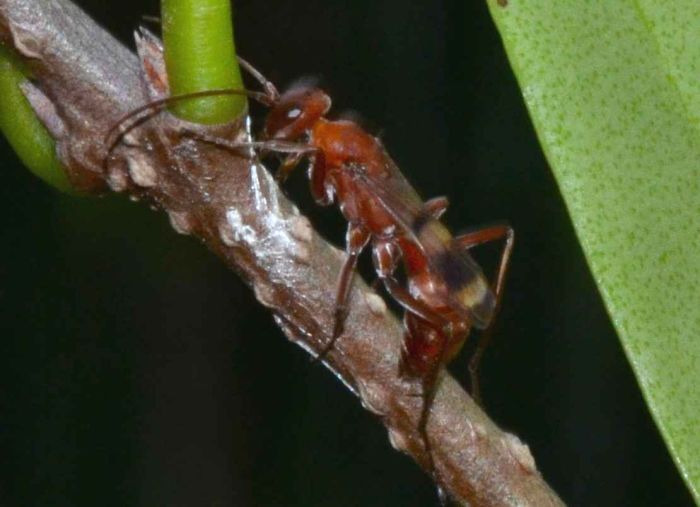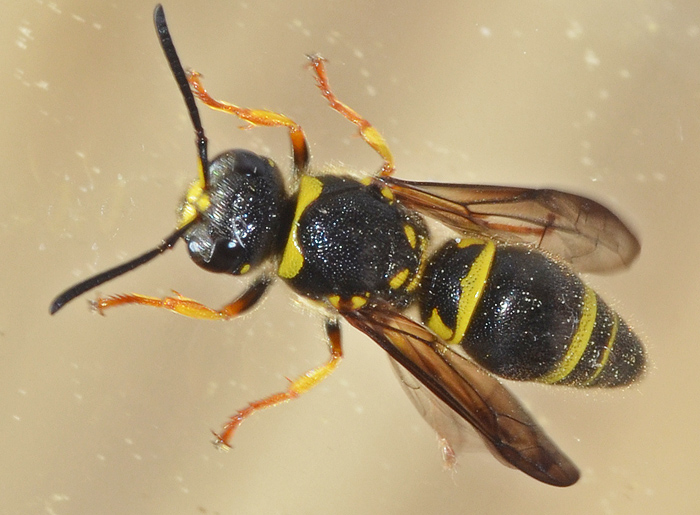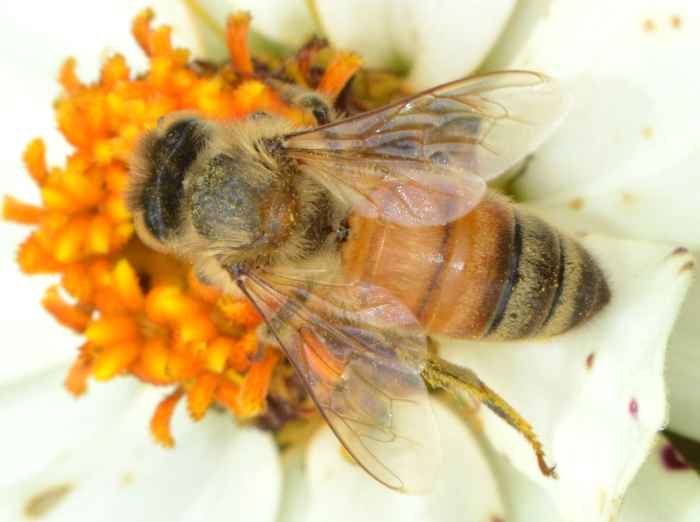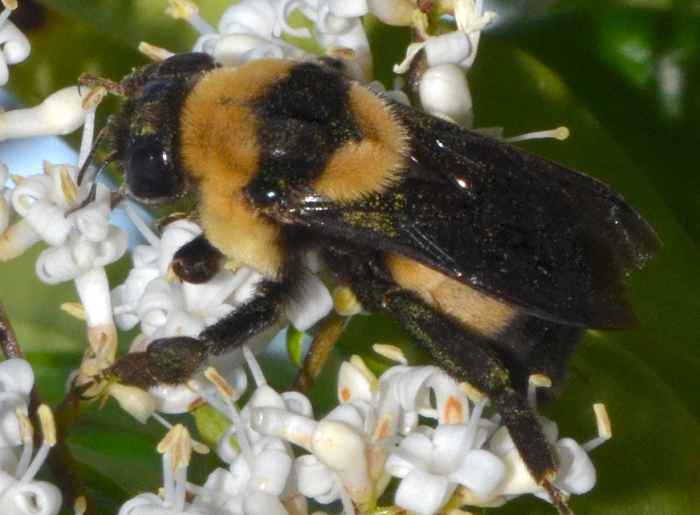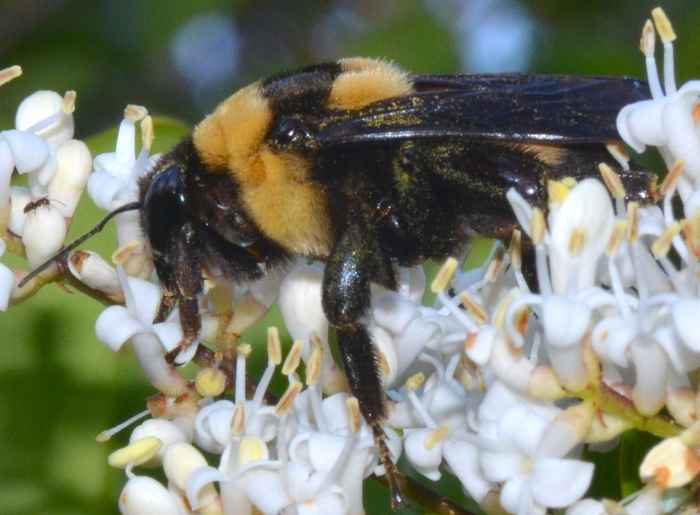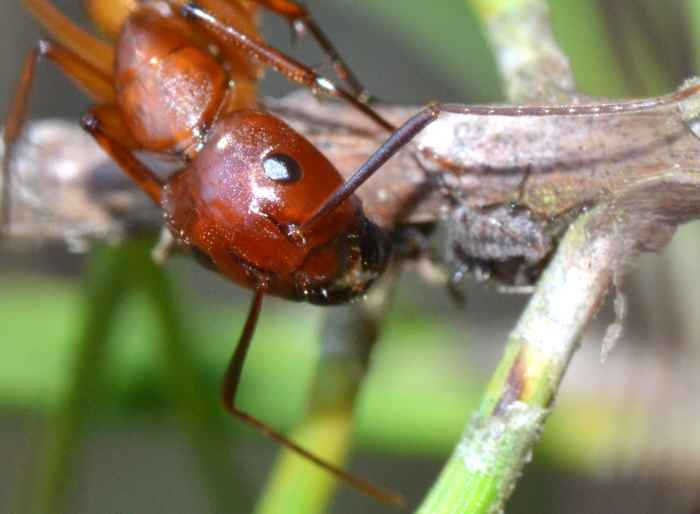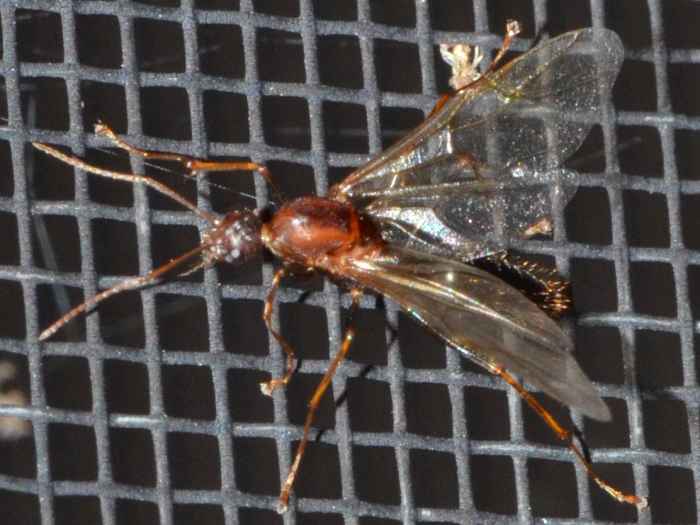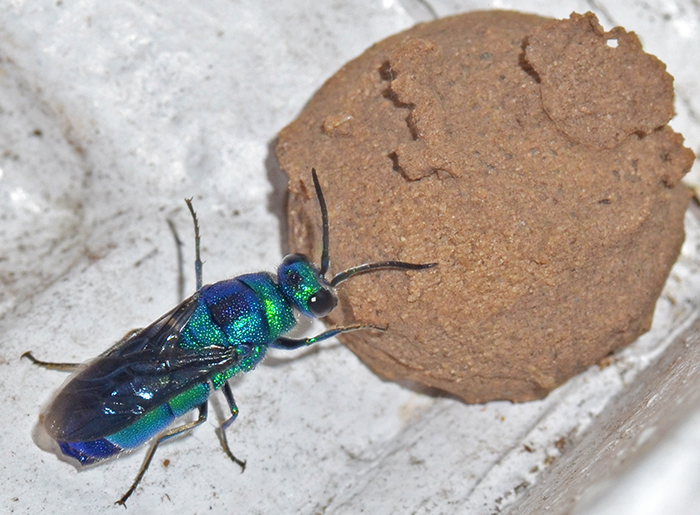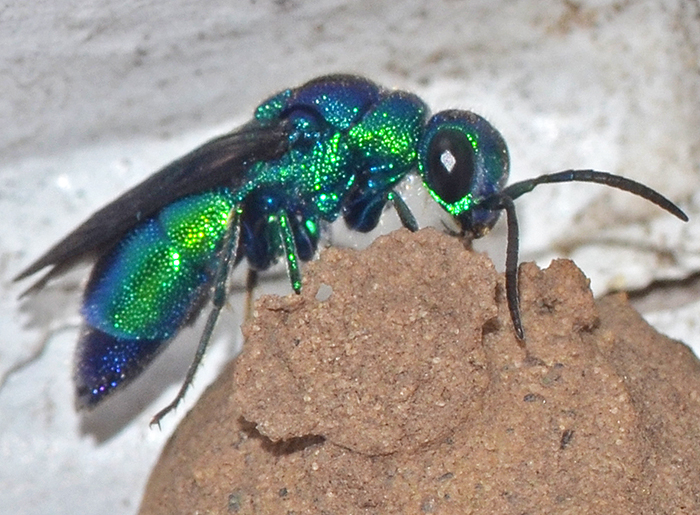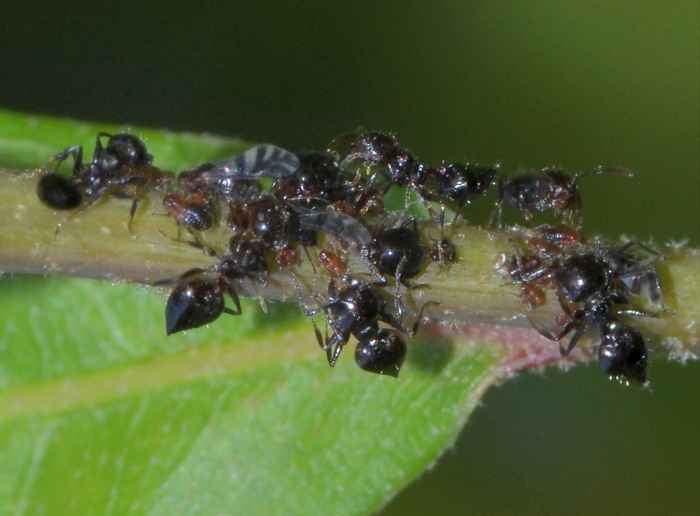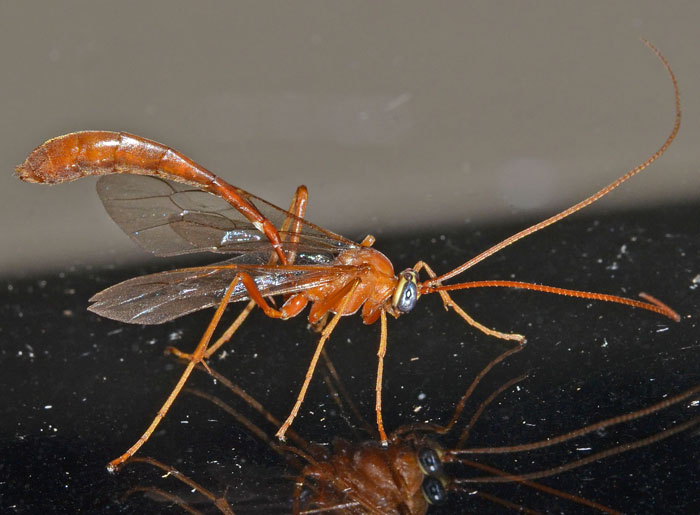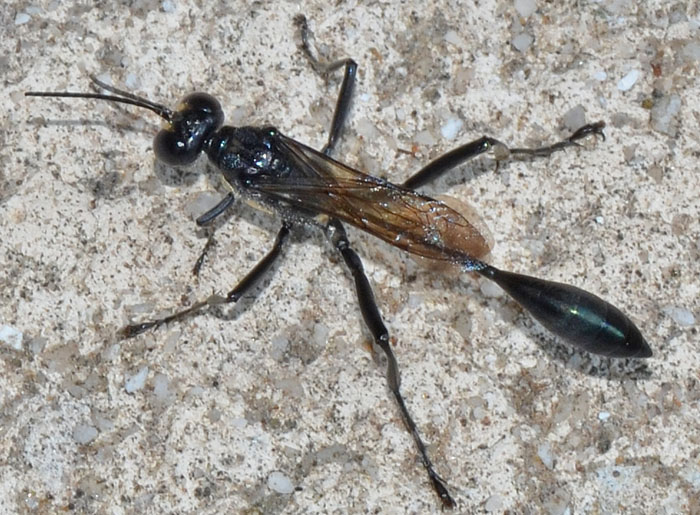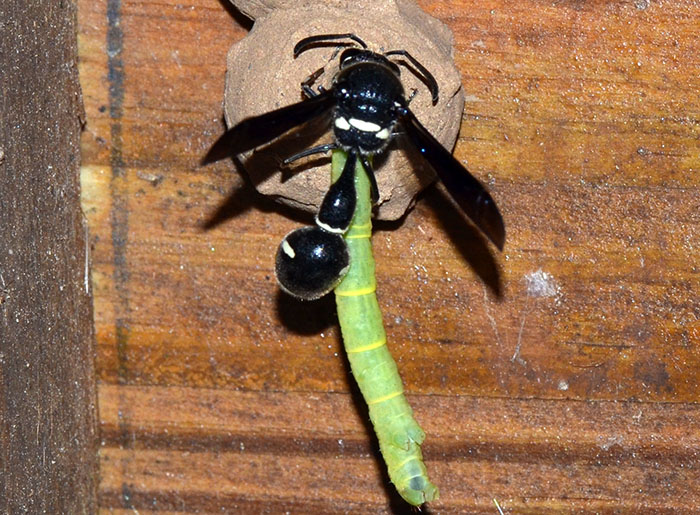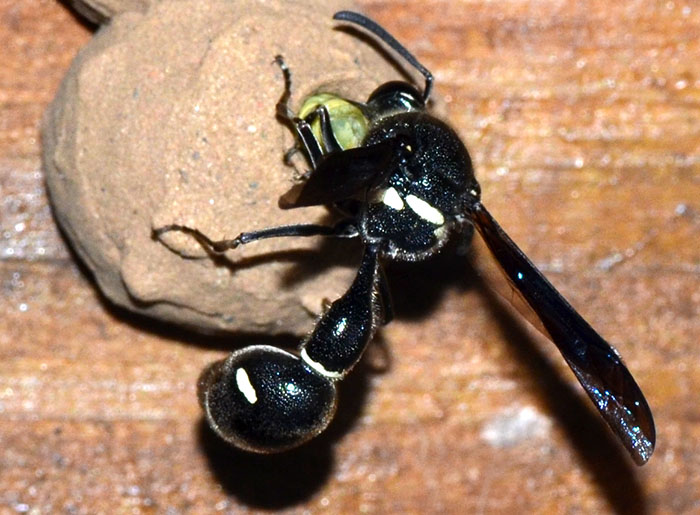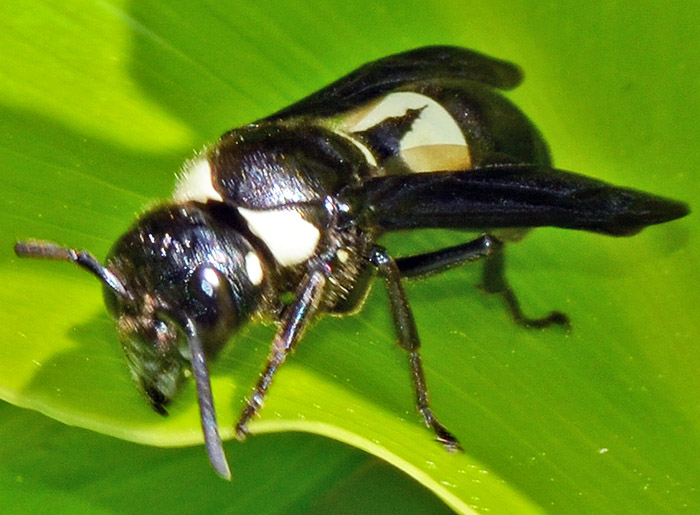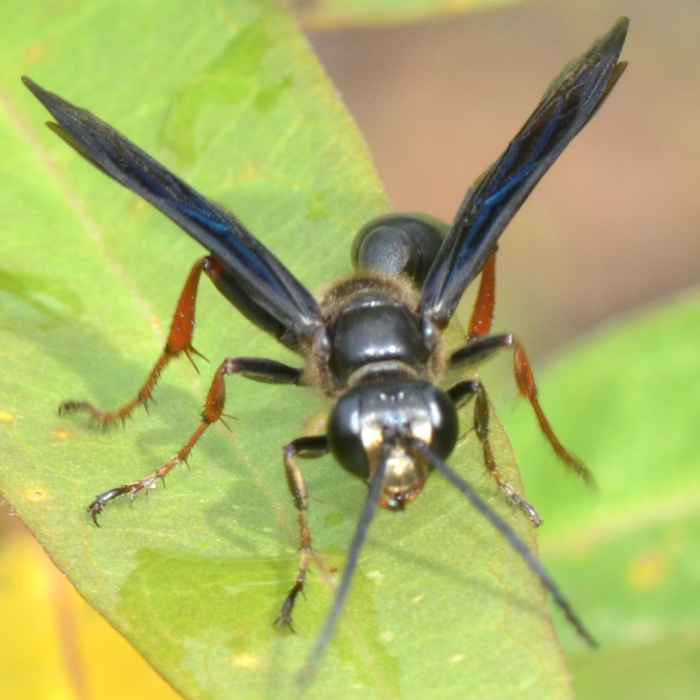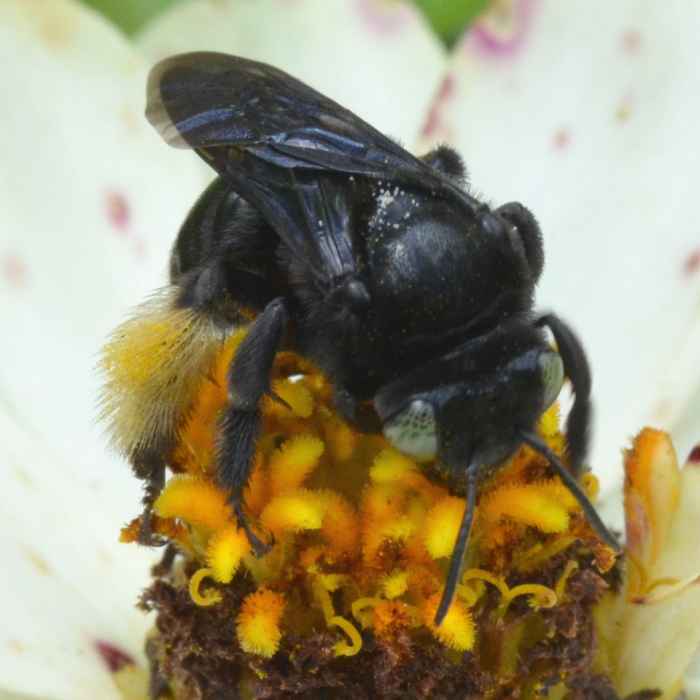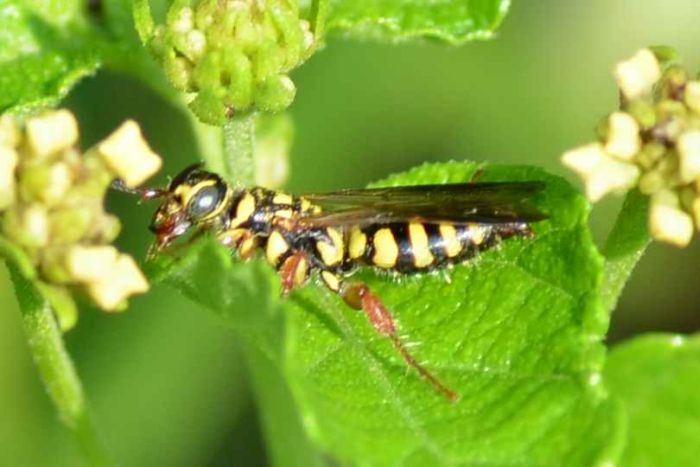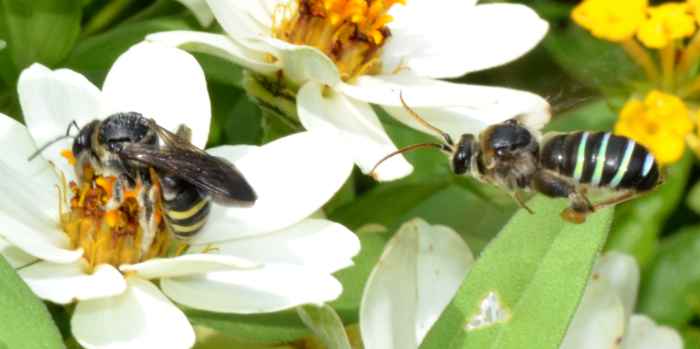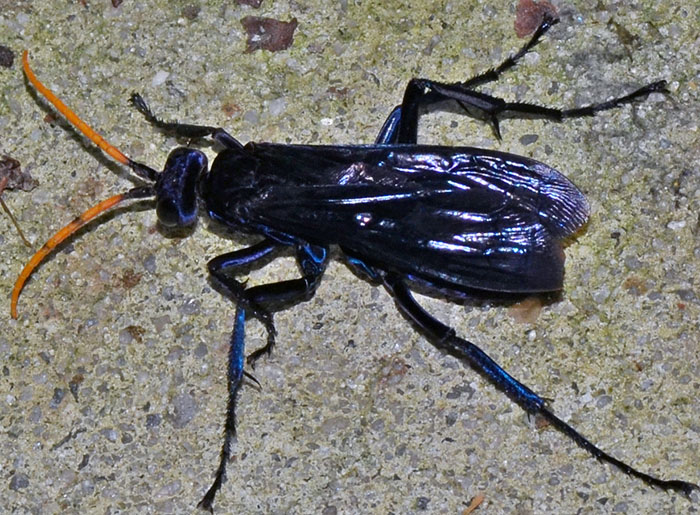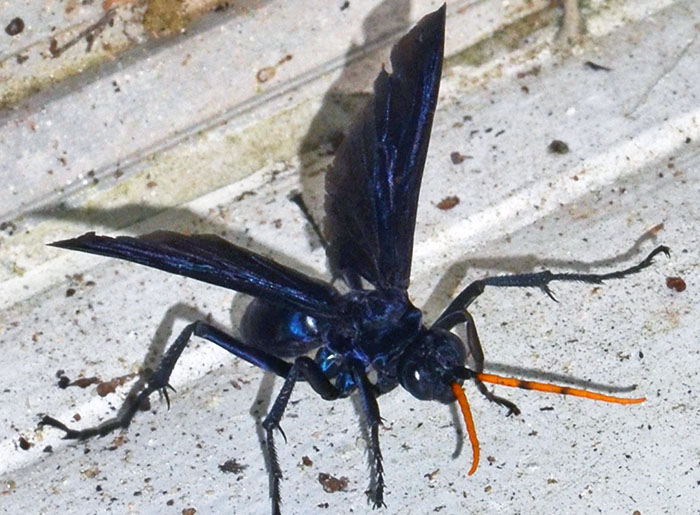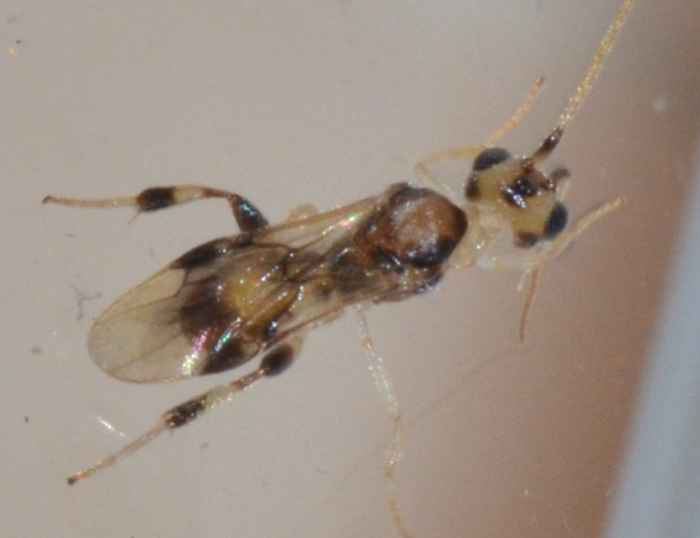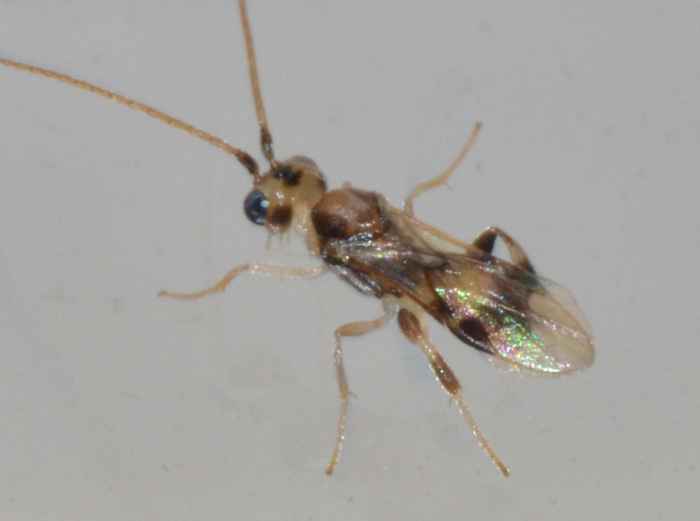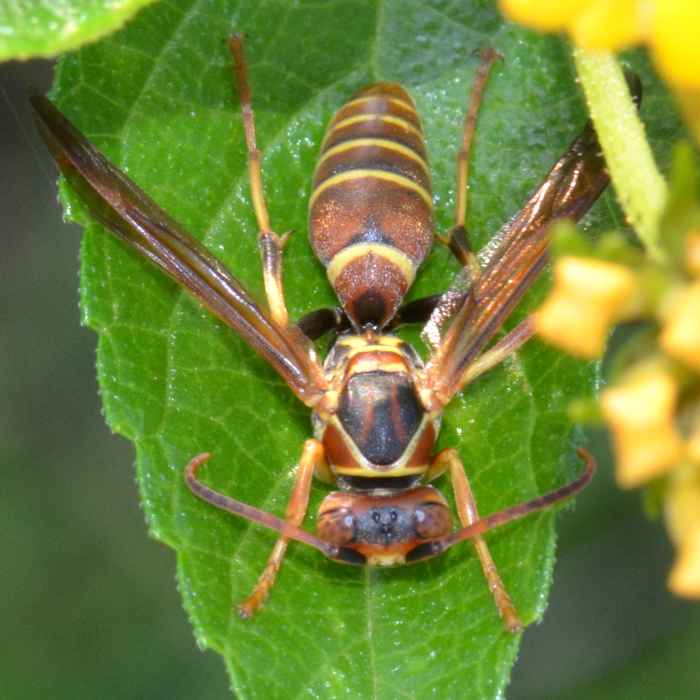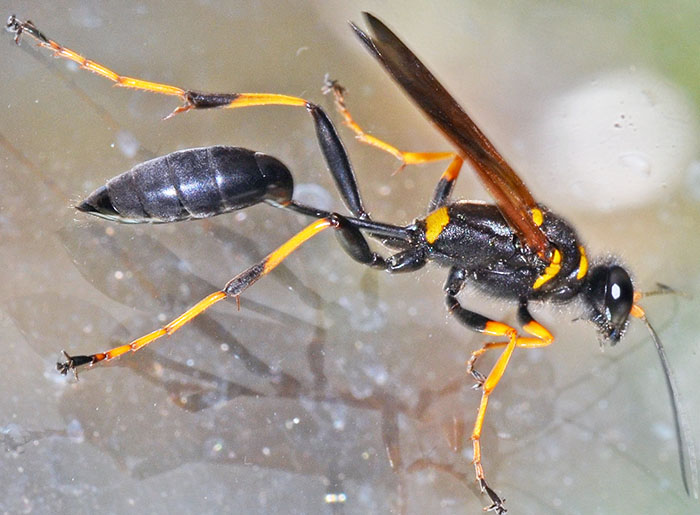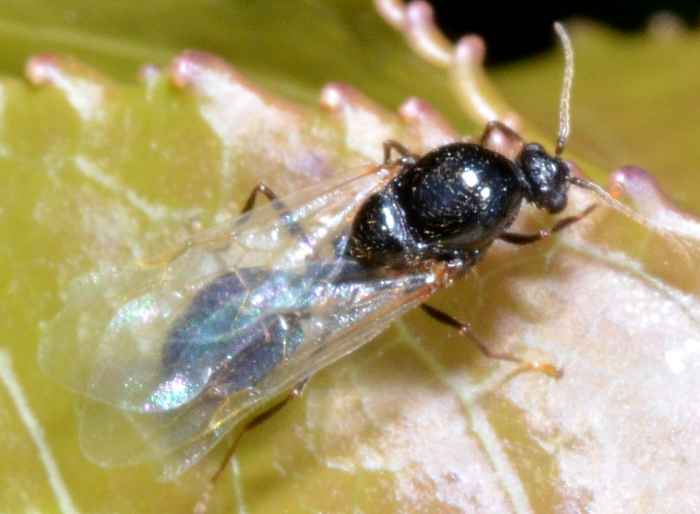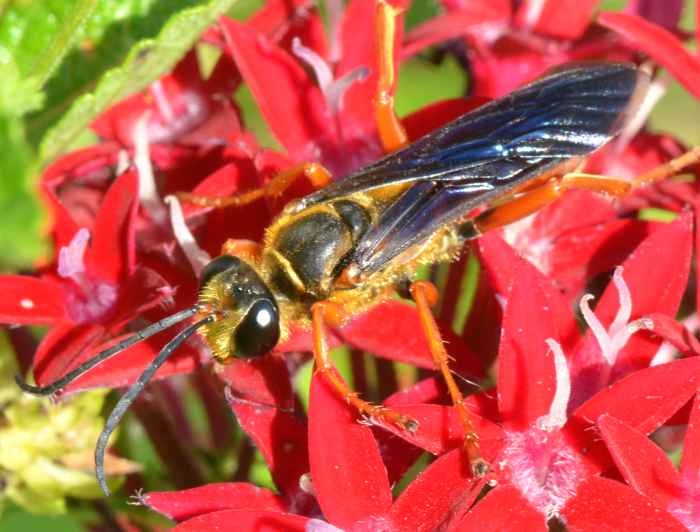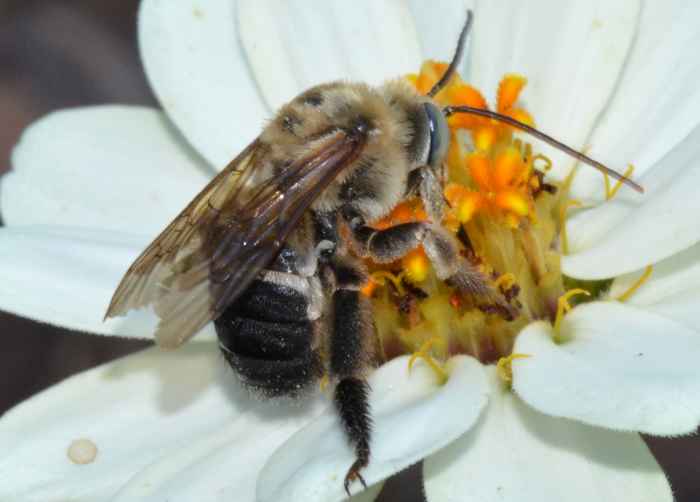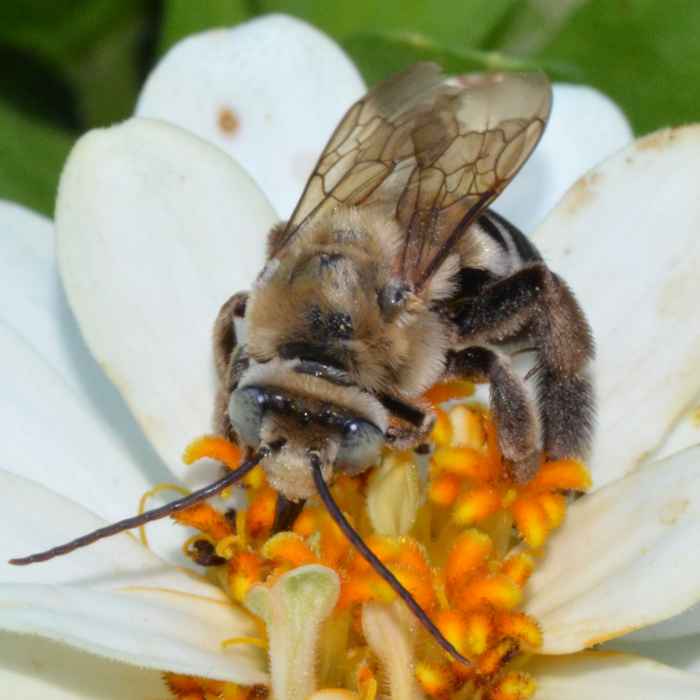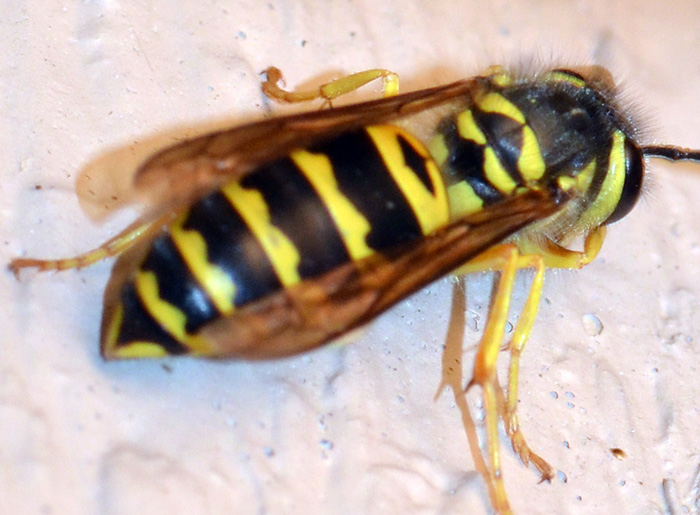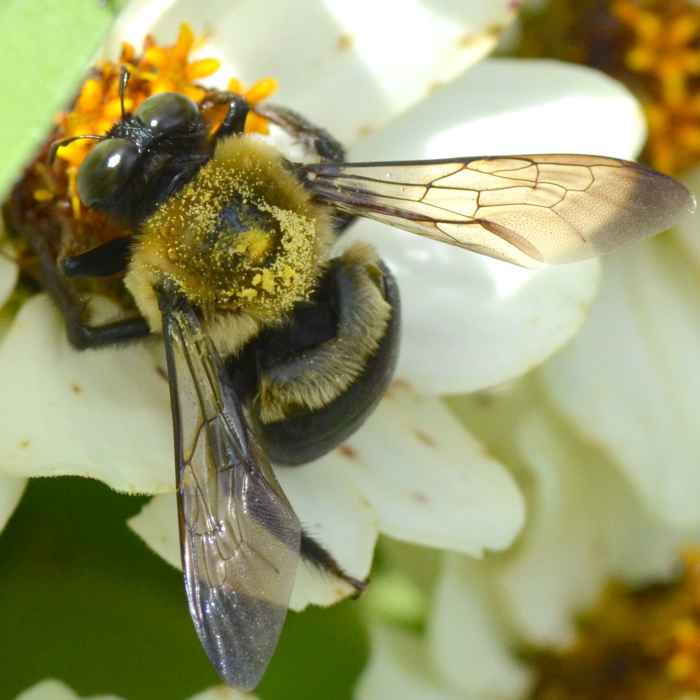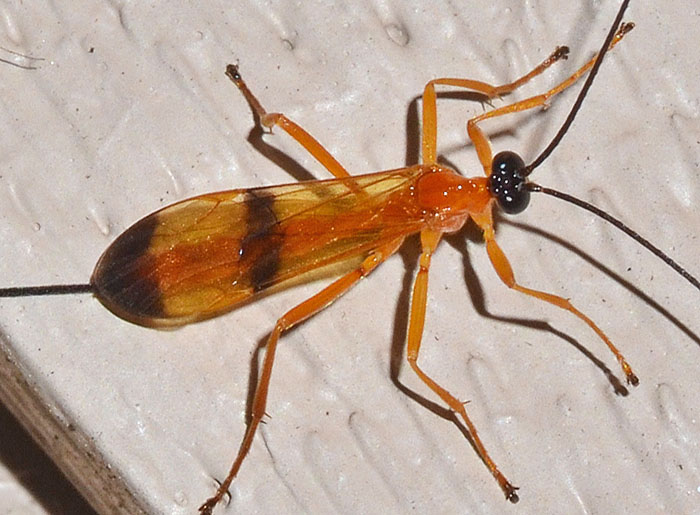 Acrotaphus wiltii ♀. | This wasp is a major foe of the arabesque orb weaver, Neoscona arabesca. The wasp stings the spider to briefly paralyze it while she lays a single egg on it. The larva is an external parasite. Acrotaphus wiltii is the only slender species with black bands on orange to yellowish wings.
bug guide (this photo): http://bugguide.net/node/view/1085672 | ||
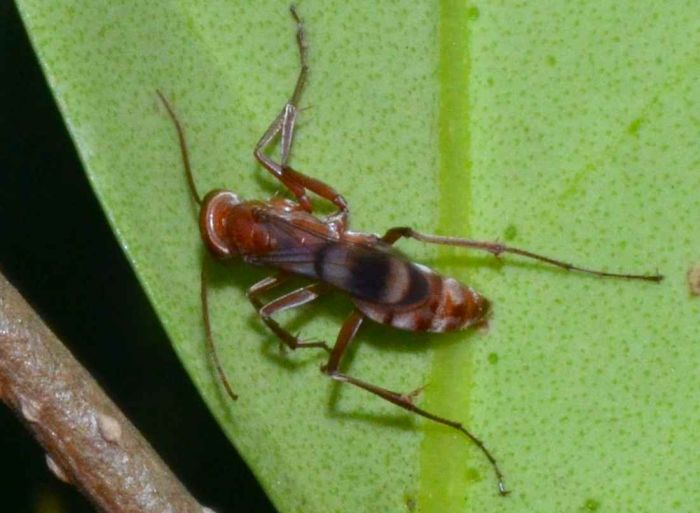 Ageniella sp. (Spider Wasp). | This spider wasp belongs to the rather larger genus Ageniella which has 35 species in North America. A. conflicta has striped wings like this wasp. It reminded me of a velvet ant but that's wrong (like many of my guesses). The small photo shows a side view of the same specimen.
bug guide (this photo): http://bugguide.net/node/view/559278 | ||
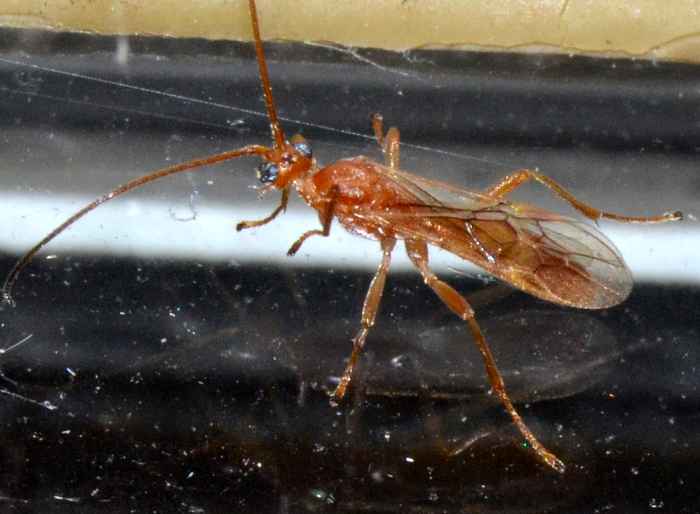 Aleiodes sp. (Mummy-wasp). | Over 200 species in this genus. Mummy wasps attack leaf-feeding caterpillars and mummify the victim. This unique method of parasitism leaves the caterpillar intact and identifiable while the wasp larva feeds and eventually pupates inside the caterpillar. bug guide (this photo): http://bugguide.net/node/view/634174 | ||
 Ammophila procera (Thread-Waisted (Digger) Wasp). | One of my coolest picture so far. This wasp was massive!
It is a thread-waisted (digger) wasp. The scientific name is Ammophila procera. They are solitary wasps and females dig and provision chambers for their offspring. They prefer sandy clay soil and hunt hairless caterpillars to feed their larva (one per egg). I initially thought that it's A. nigricans but a bug guide expert corrected it (thanks!) - this one has silver lines on its thorax. bug guide (this photo): http://bugguide.net/node/view/15540 discoverlife: http://www.discoverlife.org/mp/20q?guide=Sphecidae Bentler: http://www.bentler.us/eastern-washington/animals/insects/wasps/thread-waisted-wasp.aspx | ||
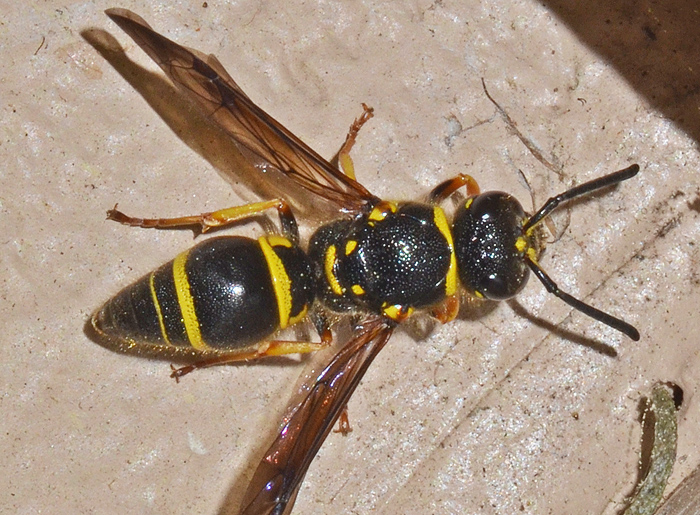 Ancistrocerus campestris. | Look at this smiley face--one happy wasp. A. unifasciatus and A. lutonidus are very similar sister species. The small photo shows a different specimen (09/04/16 at 1 pm).
bug guide (this photo): http://bugguide.net/node/view/1206691 | ||
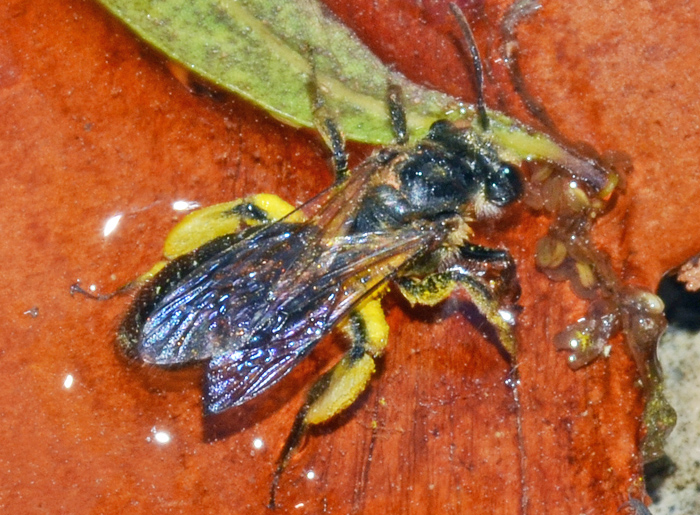 Andrena sp.. | Not a good photo but anyway, I've rescued this Mining Bee from our pool. It has been identified as Andrena which includes over 450 species (47 subgenera) in North America alone. bug guide (this photo): http://bugguide.net/node/view/1206566 | ||
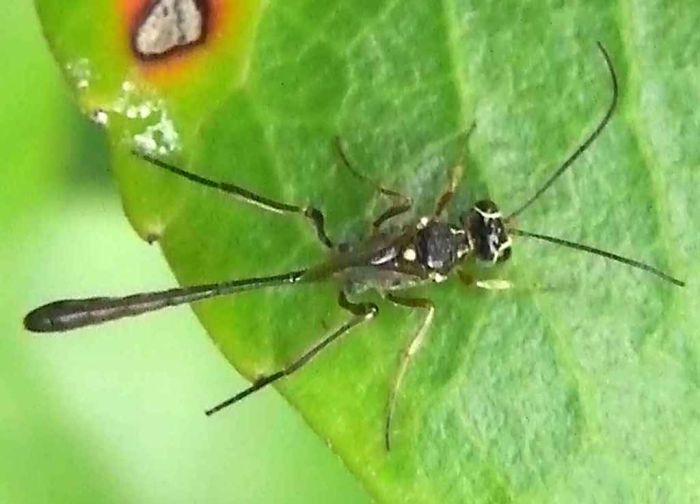 Anomalon sp. (Ichneumon Wasp). | This insect was so small that, before looking at the photo, I had no idea that it could be a wasp. More precisely it's a ichneumon wasp. They are slender with long antennae, parasitic, and have thousands of species in North America. This one belongs to the genus Anomalon which has only 12 species in the US. A bug guide expert determined that it is a male. bug guide (this photo): http://bugguide.net/node/view/545629 Tom Murray: http://www.pbase.com/tmurray74/ichneumon_subfamily_anomaloninae BBC video: http://www.youtube.com/watch?v=SLvuevf__Ok | ||
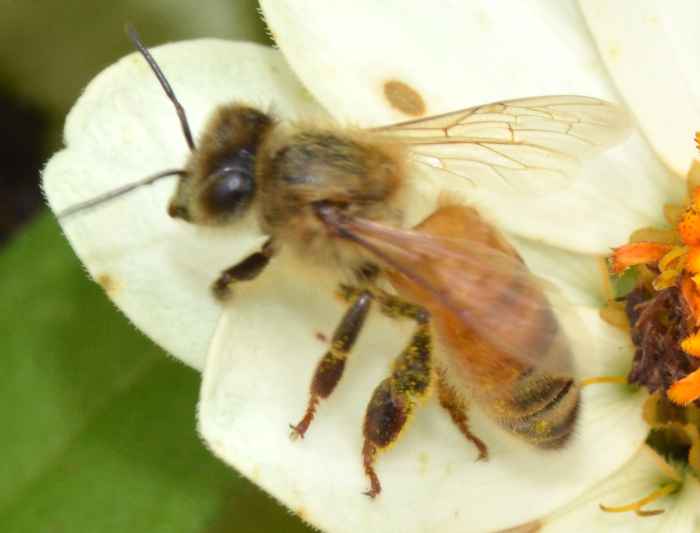 Apis mellifera (Honey Bee). | A Honey Bee (Apis mellifera). Honey bees are not native to the Americas but were introduced by Europeans settlers. There are about six recognized subspecies in our area. Wild bees are mostly hybrids.
bug guide (these photos): http://bugguide.net/node/view/572469 wikipedia: http://en.wikipedia.org/wiki/Western_honey_bee | ||
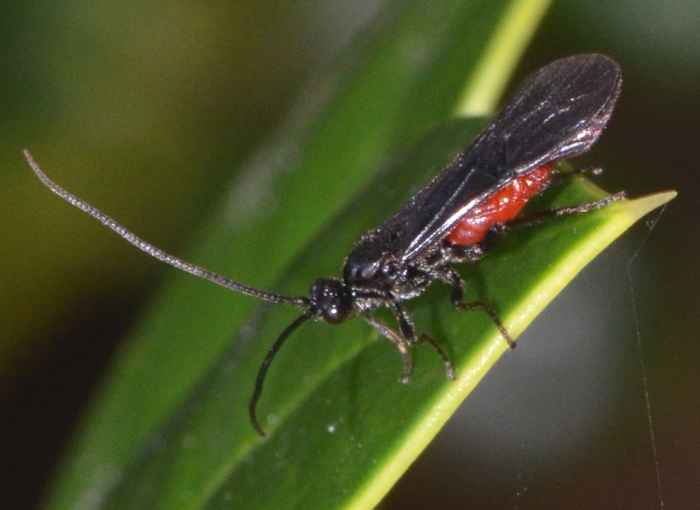 Atanycolus sp. (?) (Braconid Wasp (nonspec.)). | This is a Braconid wasp, possibly in Atanycolus which has 36 species in North America. This genus is a common one within its subfamily but the bugguide warns that it is "next to impossible to identify this genus from images alone". bug guide (this photo): http://bugguide.net/node/view/571805 | ||
 Augochlora sp. (pura?) (Sweat Bee). | One busy "sweat bee" ...
The 'green metallic bee' belongs to the very large family Halictidae. Perhaps it is Augochlora pura but I'm not sure. All sweat bees are attracted by sweat (to lick off salt) and can sting. I love the Wikipedia statement that their "sting is only rated a 1.0 on the Schmidt Sting Pain Index, making it almost painless." wikipedia: http://en.wikipedia.org/wiki/Halictidae bug guide: http://bugguide.net/node/view/128 discoverlife: http://www.discoverlife.org/mp/20q?guide=Bee_genera: | ||
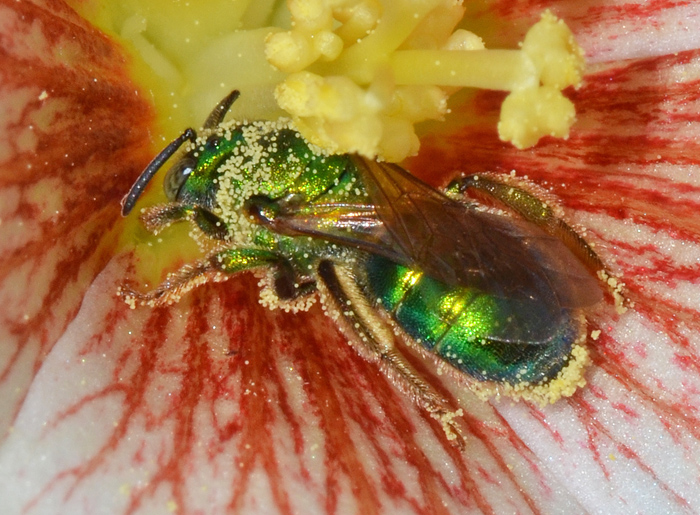 Augochloropsis sp. ♀. | Hard to believe that an expert on bugguide.net could identify this sweat bee for me. The flower is from a tung oil tree Vernicia fordii which are common in our neighborhood. In 1905 the Dept. of Agriculture introduced the tree in Florida and other Gulf states. Later the flourishing American tung oil industry was wiped out by frost and hurricanes and the plantations never recovered. Today the tree is listed as an invasive species. Unfortunately they are also very poisonous and can cause rash. bug guide (this photo): http://bugguide.net/node/view/1206692 wikipedia (for the flower): https://en.wikipedia.org/wiki/Vernicia_fordii | ||
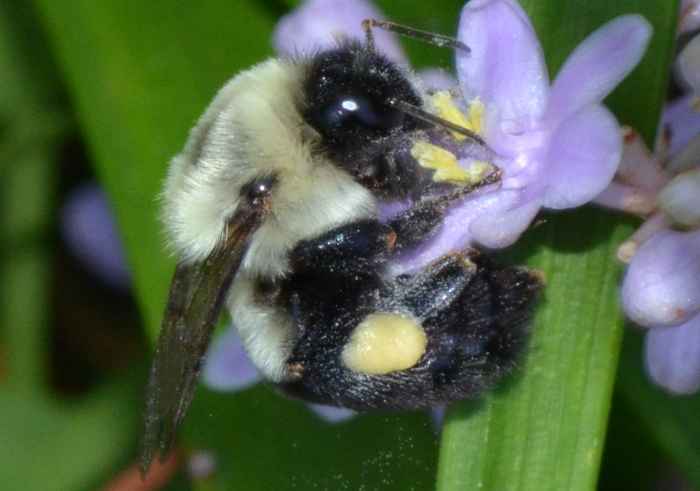 Bombus impatiens (Common Eastern Bumble Bee) ♀. | A typical bumble bee worker. This is the Common Eastern Bumble Bee (Bombus impatiens). The species has unusually large colonies and a very long flight season. It can be found in the Eastern half of the US. bug guide (this photo): http://bugguide.net/node/view/577713 | ||
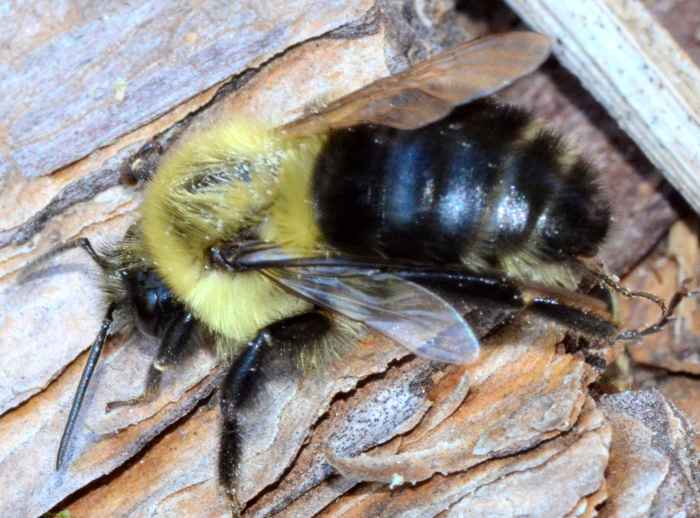 Bombus impatiens (Common Eastern Bumble Bee) ♂. | This specimen is a male of the species Bombus impatiens. Early in the colony cycle, the queen is usually the mother of all males laid. Later workers begin to lay male eggs. New queens and males leave the colony after maturation. Males in particular are forcibly driven out by the workers. bug guide (this photo): http://bugguide.net/node/view/591054 wikipedia: http://en.wikipedia.org/wiki/Bumble_bee | ||
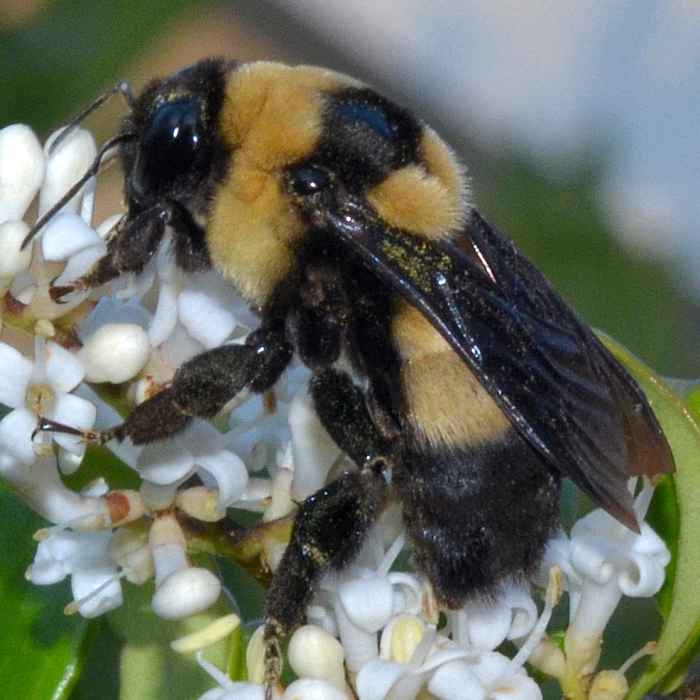 Bombus fraternus (Southern Plains Bumble Bee). | I found this big bumble bee on an evergreen ligustrum (privet) tree. It is a Southern Plains Bumble Bee (Bombus fraternus) which is native to the US east of the Rocky Mountains. This fairly uncommon species has its hairs pressed closely against the body, which distinguishes it from most other "fluffy" species. I believe that this specimen is a queen or a male, which are larger than the workers.
bug guide (these photos): http://bugguide.net/node/view/635540 Discover Life: http://www.discoverlife.org/mp/20q?search=Bombus+fraternus Wikipedia: http://en.wikipedia.org/wiki/Bombus_fraternus | ||
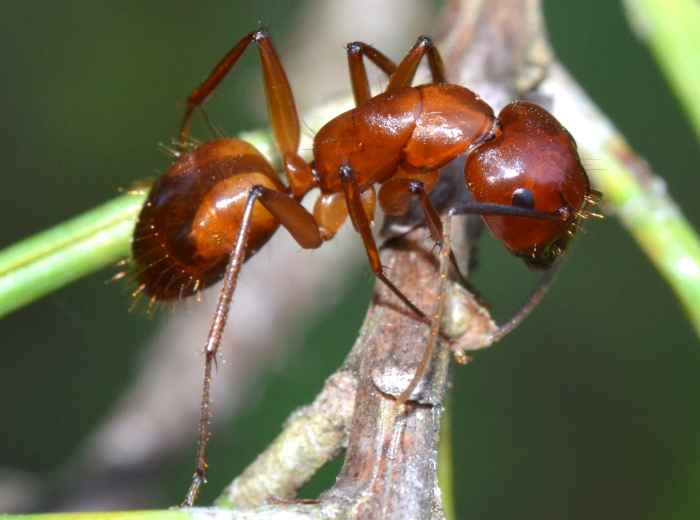 Camponotus sp. (Carpenter Ant). | No, they do not eat wood :) These are Carpenter Ants (Camponotus sp.) on a pine tree twig. There are over 50 species in the US. Some nest in damp wood (others in soil) and hollow out small parts of trees. The black carpenter ant (C. pennsylvanicus) is the most likely one to infest houses (these here aren't black). All ants in this genus have an obligate bacterial endosymbiont (Blochmannia).
bug guide (this photo): http://bugguide.net/node/view/564688 wikipedia: http://en.wikipedia.org/wiki/Carpenter_ant | ||
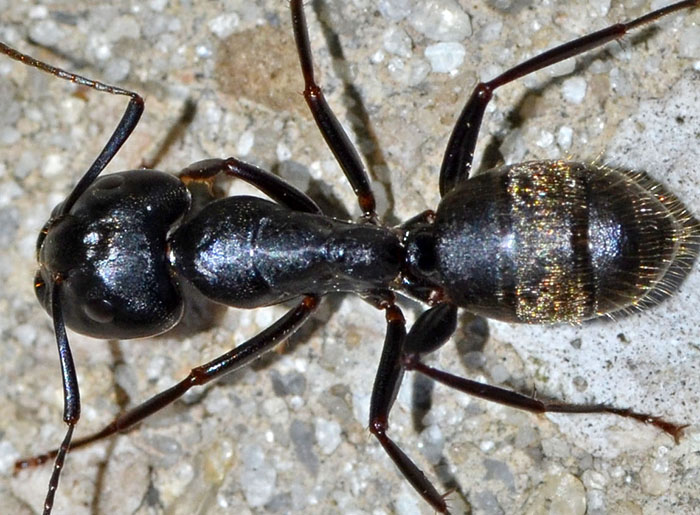 Camponotus pennsylvanicus | Mighty big ant, all black and covered with long, yellowish hairs. The presence of this species in Florida is limited to some counties in the north. It nests in trees and rotten logs or tree stumps. It also attacks fences, poles and buildings. This is probably the most destructive carpenter ant in North America. bug guide (this photo): http://bugguide.net/node/view/1365918 | ||
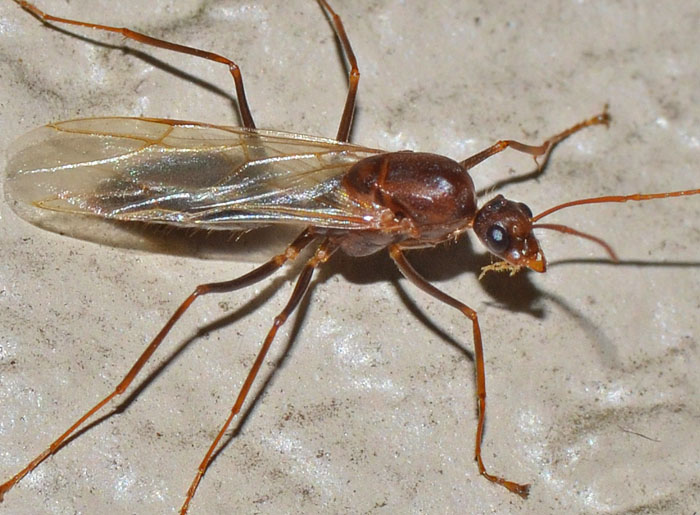 Camponotus floridanus (Florida Carpenter Ant) ♂. | This winged insect is a Florida Carpenter Ant (Camponotus floridanus). In the US it is only found in the Southeast coastal plain. The ant alate in the small photo was seemingly attracted by the light in our living room (09/19/11, 9 pm).
bug guide (this photo): http://bugguide.net/node/view/946508 UF: http://edis.ifas.ufl.edu/in455 | ||
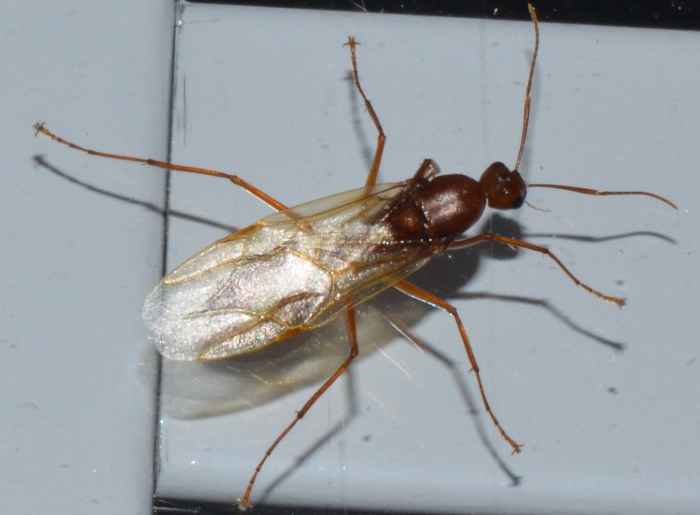 Camponotus castaneus (Reddish Carpenter Ant). | This Carpenter ant is Camponotus castaneus. It belongs to the subgenus Tanaemyrmex. Citing from Krombein et al. (Catalog of Hymenoptera in America North of Mexico): "Most species of this subgenus nest in the soil under stones or other objects; occasionally nests may be surmounted by a small crater. The ants rarely nest in wood, but, if so, the wood is usually buried in the soil." bug guide (this photo): http://bugguide.net/node/view/635312 | ||
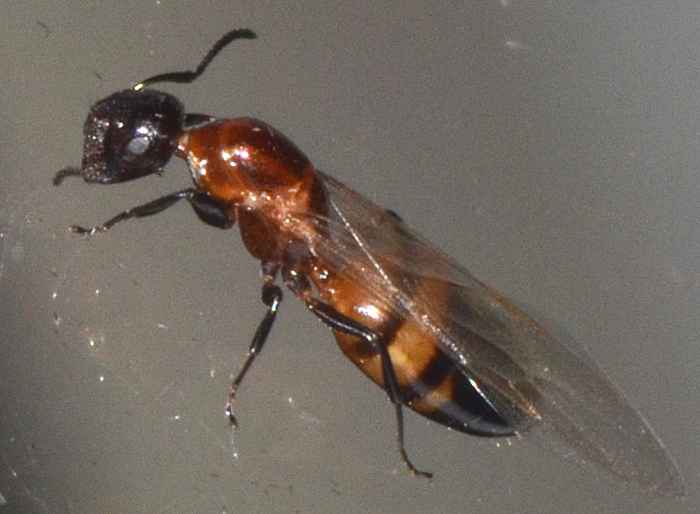 Camponotus impressus (Carpenter Ant). | This small Carpenter Ant is Camponotus impressus. It impresses with a rather sculptured body and a large head that the ant uses to block the nest entrance, allowing entry only to ants from the same nest. They live in galls, twigs, and hollow stems of woody plants. Typical tree species include ash and elderbery oak.
bug guide (this photo): http://bugguide.net/node/view/646472 | ||
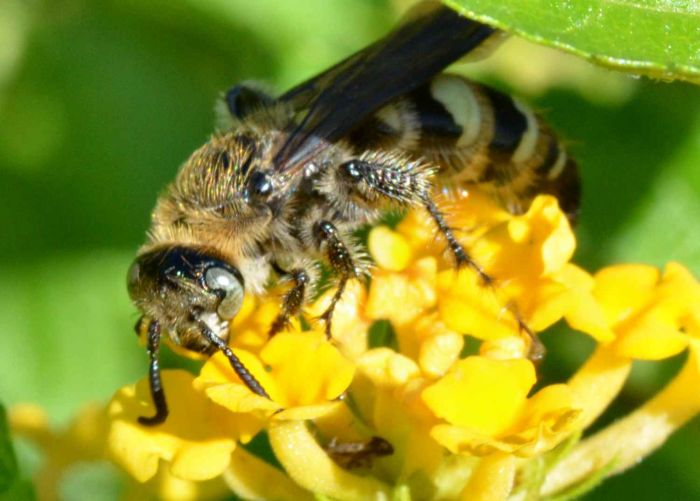 Campsomeris plumipes (Scarab-Hunter Wasp) ♀. | A scoliid wasp: Campsomeris plumipes or scarab-hunter wasp. The bug guide lists five genera for this family. They are predators on white grubs (Scarabaeidae), which they use as food for their offspring. The adults--as can be seen--nectar on flowers. bug guide (this photo): http://bugguide.net/node/view/548323 UF: http://edis.ifas.ufl.edu/in745 | ||
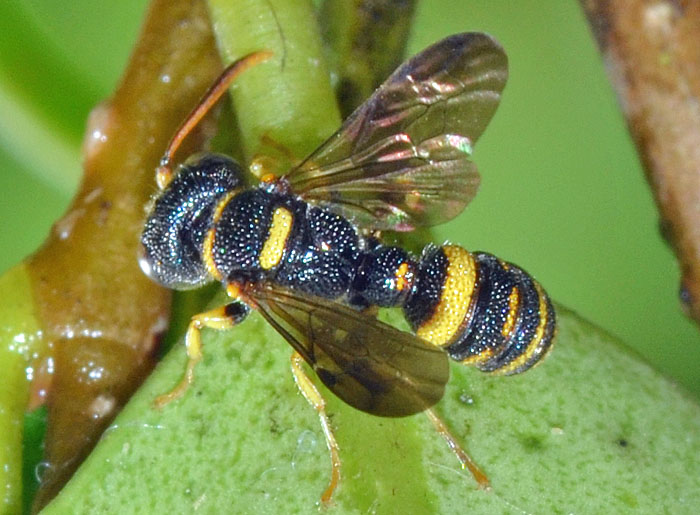 Cerceris sp.. | This small wasp belongs probably to the genus Cerceris which includes over 80 different species in the US. Most of them prey on adult beetles. bug guide: http://bugguide.net/node/view/12521 | ||
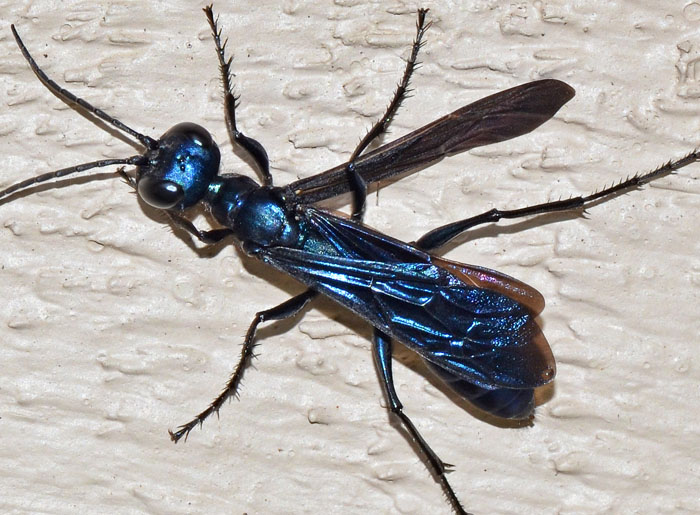 Chlorion aerarium (Steel-blue Cricket Hunter). | Steel-blue Cricket Hunters live wherever their hosts (Gryllus crickets) are found. Females mass-provision several cells with each 2 to 9 nymphs or adults. This hunter had lost one of its wings and fell of our house wall shortly after I took this photo. bug guide (this photo): http://bugguide.net/node/view/991912 | ||
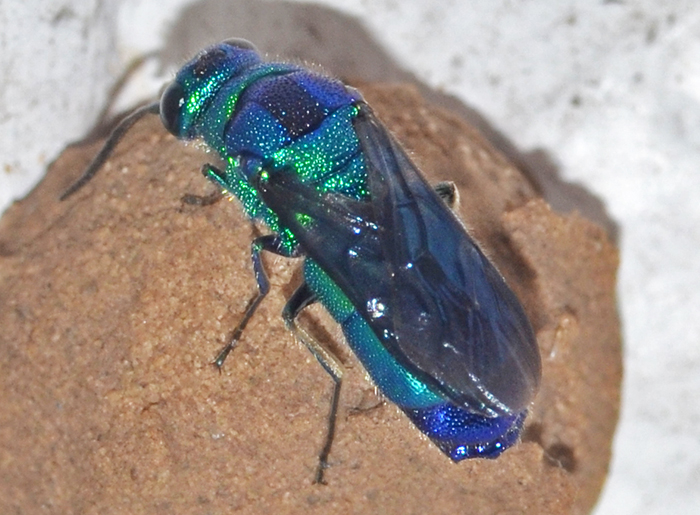 Chrysis angolensis. | Native to the Old World, where it is widespread, this cuckoo wasp species arrived in the US probably during World War II. Like other wasps in this family, it lays eggs in the nests of unrelated host species. C. angolensis specifically parasitizes the mud nests of Sceliphron caementarium which I posted here.
bug guide (these photos): https://bugguide.net/node/view/1564987 | ||
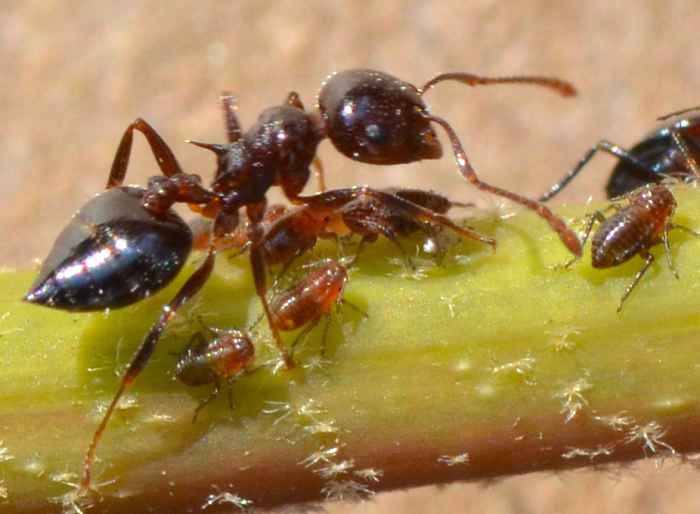 Crematogaster sp. (Acrobat Ant). | An Acrobat Ant (Crematogaster sp.) taking care of aphids. When viewed from the top, these ants have an unusual, heart-shaped gaster (the bulbous posterior portion or rear end). The genus has 28 species in North America. Based on the spines on the ant's back, my guess for this specimen is C. atkinsoni which are known to exist in Florida.
bug guide (this photo): http://bugguide.net/node/view/632809 Iowa State University: http://www.ipm.iastate.edu/ipm/iiin/aacrobat.html | ||
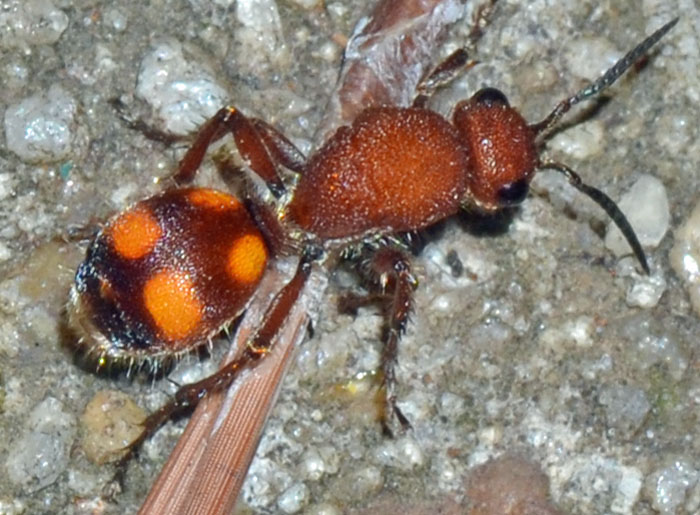 Dasymutilla quadriguttata. | This is probably the first velvet ant that I have ever seen. It crossed our parking place at high speed and it was quite challenging to take this picture. Let me add that females can inflict a painful sting. They are also called "Cow Killers". Notice that this family belongs to the wasps, although especially the wingless females clearly resemble large ants. Velvet ants are solitary and typically hairy.
bug guide (this photo): http://bugguide.net/node/view/970193 | ||
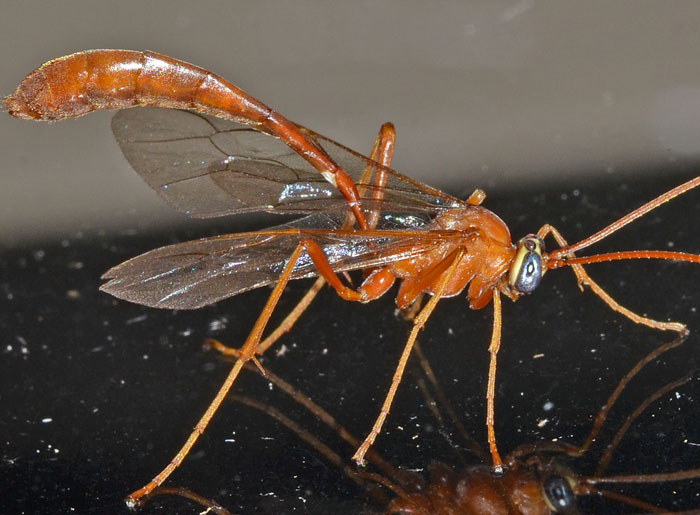 Enicospilus sp.. | A really big Ichneumon Wasp with a somewhat pre-historic appearance. The wasp was attracted to our porch lights and then rested on our living room window for a while. The genus Enicospilus has twelve species in North America. This one seems to belong to the americanus group. A high-resolution version of the photo is available here.
bug guide (this photo): http://bugguide.net/node/view/986757 | ||
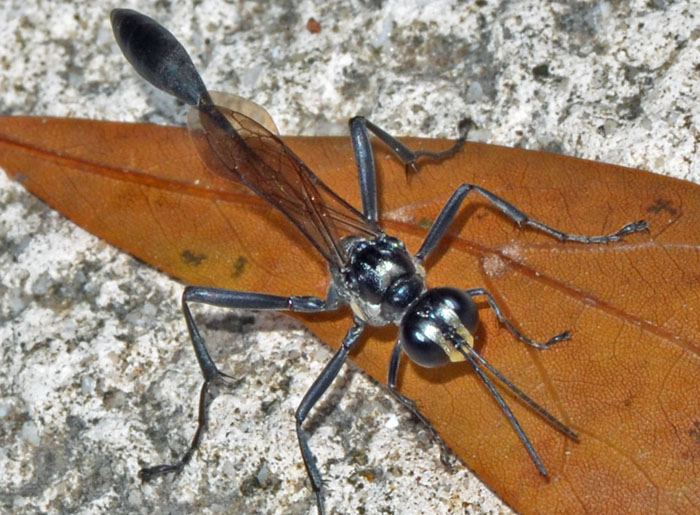 Eremnophila aureonotata ♂. | I found these wasps near our pool on a sunny day but really never saw them again. They are very similar to Ammophila species. Adults take nectar and are often found mating on wildflowers. Females dig burrows and provision them with single large caterpillar of moths and skippers.
bug guide (this photo): http://bugguide.net/node/view/972400 | ||
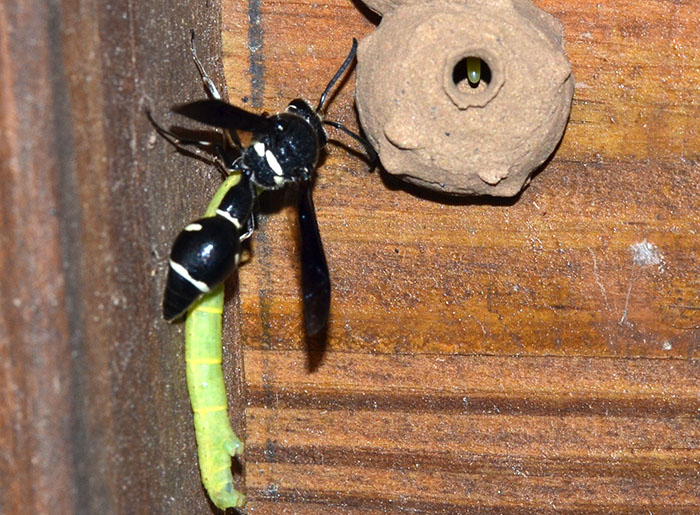 Eumens fraternus (Potter Wasp). | The common Potter Wasp (Eumenes fraternus) builds small spherical mud nests and provisions each with a caterpillar etc. after laying a single egg. This egg can be seen on the photo. I was quite surprised by the size of the Geometridae caterpillar which the wasp stuffed into the nest. The process took about 20 seconds. The prepupal instar overwinters in the mud pots built by the last generation of females.
bug guide (this sequence): https://bugguide.net/node/view/1573997 wikipedia: http://en.wikipedia.org/wiki/Potter_wasp | ||
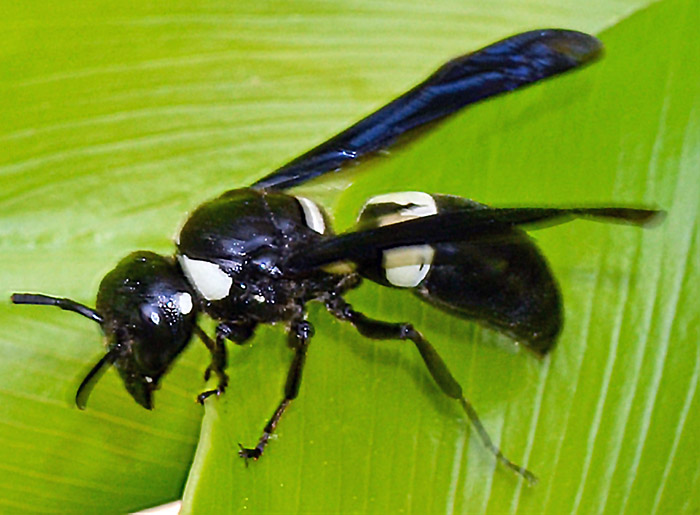 Euodynerus bidens (Mason Mimic Wasp) ♀. | Very similar to the much more common true Mason Wasp (Monobia quadridens). However, this species here has two large, white patches on the sides of the propodeum (the first abdominal segment), whereas Monobia has no or only a small spot. In addition, the white spots on the "temples" are distinctive too. Too bad that the photos didn't turn out better but it was a windy day and the wasp didn't give me much time.
bug guide (these photos): https://bugguide.net/node/view/1509572 | ||
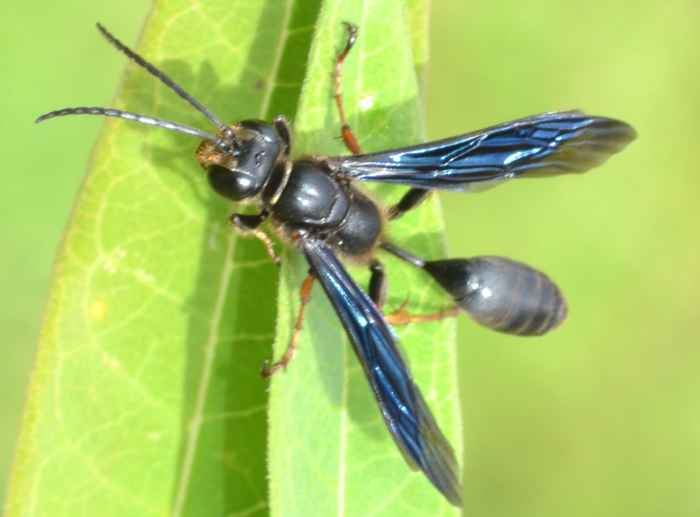 Isodontia auripes (Brown-Legged Grass-Carrier). | I believe this is a Brown-Legged Grass-Carrier (Isodontia auripes). It is found in the Easten US. The brown legs are characteristic. They belong to the grass-carrying wasps because they use grass blades to partition cells and form closing plugs in their cavity nests.
bug guide (these photos): http://bugguide.net/node/view/572477 U Michigan: http://insects.ummz.lsa.umich.edu/sphecidwasps/Isoauripes.html | ||
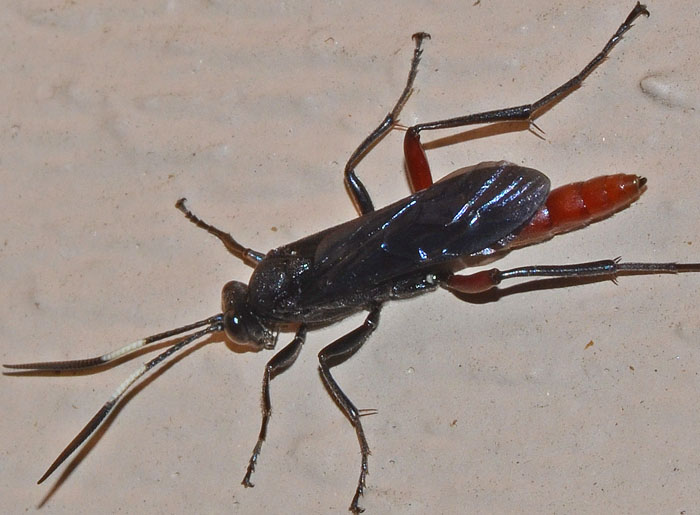 Limonethe maurator ♀. | I couldn't find any information on this wasp with the exception of contradictory information on its host insects. This specimen was attracted to attracted to our porch lights. bug guide (this photo): http://bugguide.net/node/view/1078465 | ||
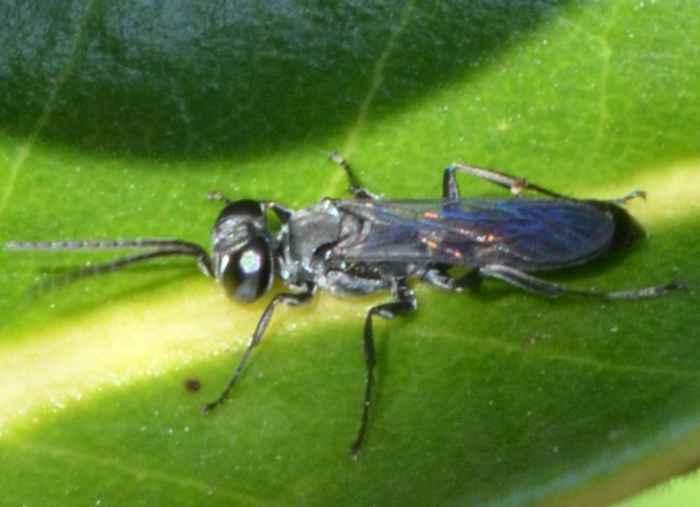 Liris sp. (Square-Headed Wasp (nonspecific)). | Not a good photo but the bugguide folks identified it as a Square-Headed Wasp (Liris sp.). North America has 15 (24?) species in this genus. L. argentatus is a shiny black species that is widespread in the US (p. 27, third link). bug guide (this photo): http://bugguide.net/node/view/565884 UF: http://natl.ifas.ufl.edu/Wasps2.htm K. V. Krombein Revision of North American Liris Fabricius (Smithsonian, 1984): http://alturl.com/4ygg5 | ||
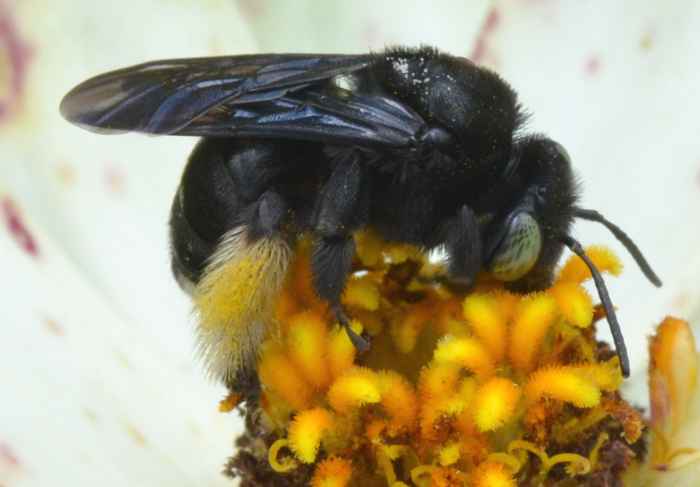 Melissodes bimaculata (Long-Horned Bee (nonspec.)). | A black bee with one pair of legs covered in white/yellow fur. This is Melissodes bimaculata. The genus is wide-spread throughout the US and has over 100 species. The species name "bimaculata" refers to a pair of white spots near the tip of the abdomen, which cannot be seen on these photos.
bug guide (these photos): http://bugguide.net/node/view/573785 discoverlife: http://www.discoverlife.org/20/q?search=Melissodes+bimaculata | ||
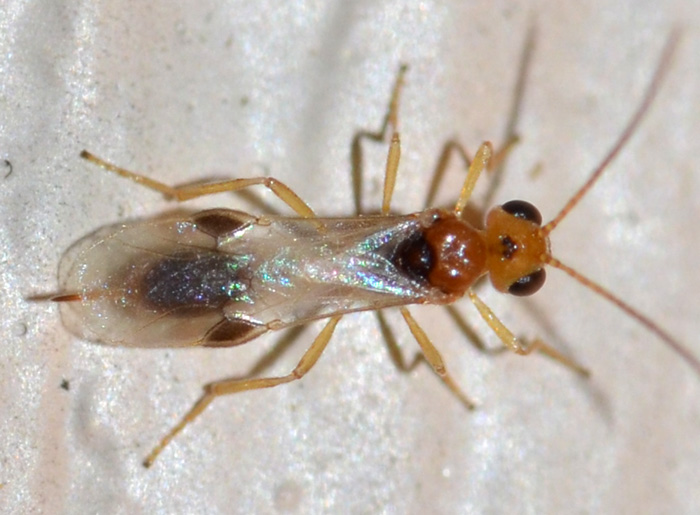 Meteorus sp. ♀. | A small Braconid wasp. The genus Meteorus has 40 species in the North America and at least 332 species worldwide. bug guide (this photo): https://bugguide.net/node/view/1659539 H. Aguirre et al., ZooKeys 489, 33, 2015: https://zookeys.pensoft.net/articles.php?id=4942 | ||
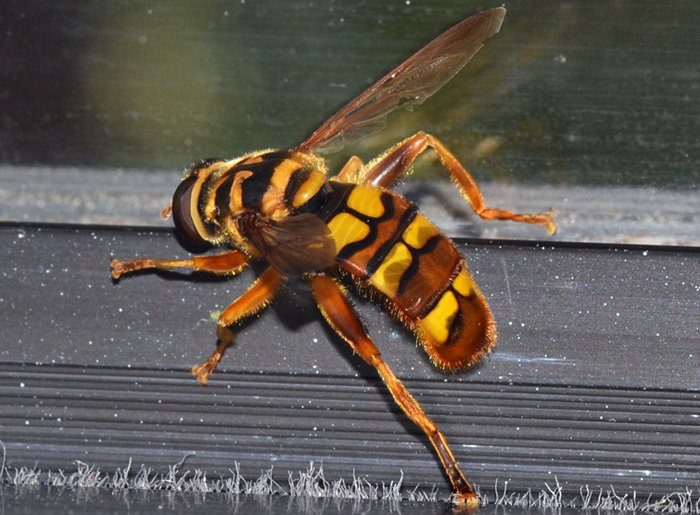 Milesia virginiensis (Yellowjacket Hover Fly). | Since we have yellowjackets, I was pretty convinced that this is one of those dangerous fellas. However, it turned out to be only a big hover fly that mimics the Southern Yellowjacket. Citing from the field guide by Eaton&Kaufman: "Flies aggressively and buzzes like a hornet. In the south, sometimes called the '[good] news bee' for its habit of hovering in front of a person "giving the news". It is also said to be good luck if one can get the insect to perch on a finger, no doubt because this is difficult to do."
bug guide (this photo): https://bugguide.net/node/view/1730385 | ||
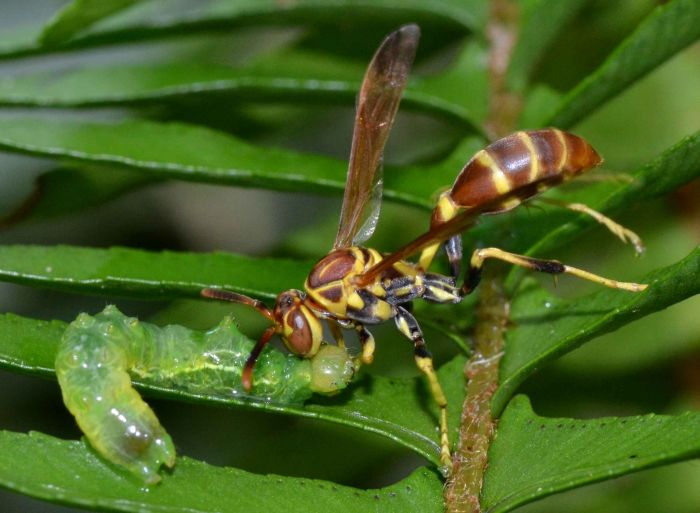 Mischocyttarus mexicanus cubicola (Paper Wasp). | A 'paper wasp' interacting with another neighbor in my yard. This wasp is Mischocyttarus mexicanus cubicola. It is a close relative of the wasps in the Polistes genus. bug guide (this photo): http://bugguide.net/node/view/549560 | ||
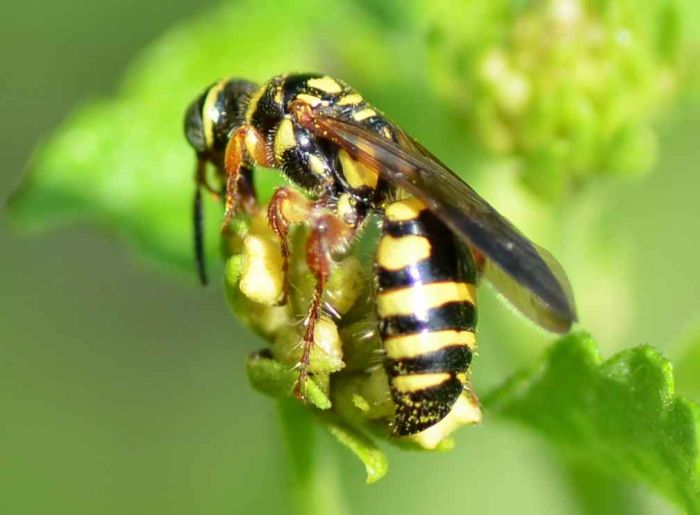 Myzinum sp. (Tiphiid Wasp) ♀. | There are ten species of Myzinum in North America. Females are more robust and have curled antennae that are shorter than in their male counterparts. Females lay one egg per provision host (typically soil-dwelling white grubs). First the larvae feed on non-essential tissues, later on essential organs killing the host.
bug guide (this photo): http://bugguide.net/node/view/557361 | ||
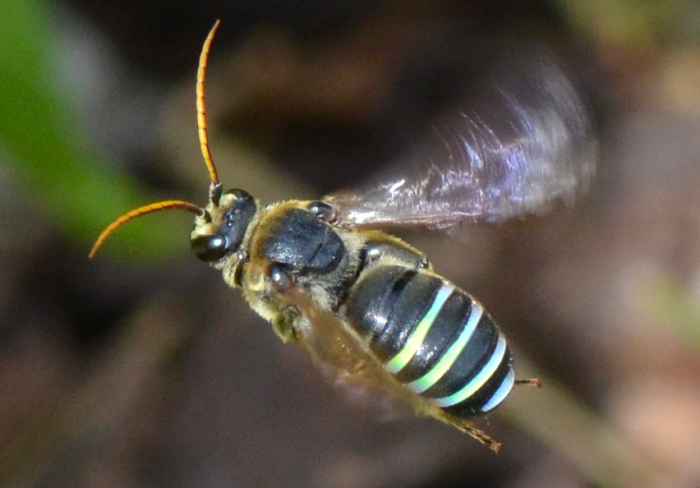 Nomia sp. (Alkali Bee). | This sweat bee is an Alkali Bee (Nomia sp.). In Greek mythology, Nomia is a daughter of Zeus and a beautiful though jealous naiad. Please have a look at the second photo and the video. They show the bee attacking a colleague, which in my opinion belongs to another species (the stripes are more yellowish than green). Unfortunately I have no idea what was going on but the attacks repeated several times. The "victim" didn't show much of a response.
 A short video is available on my YouTube channel. A short video is available on my YouTube channel.bug guide (these photos): http://bugguide.net/node/view/572643 | ||
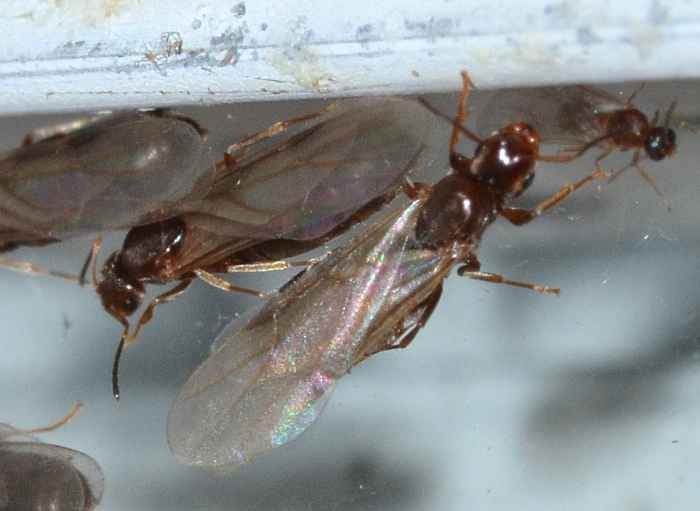 Nylanderia sp. (Crazy Ant). | The name crazy ants reflects their erratic and fast movements and their tendency not to follow trails as as other ants. These small ants live in soil, leaf litter, and rotting wood. They typically perform their mating flights in late April through May. This bunch was clearly attracted by the light in our living room. bug guide (this photo): http://bugguide.net/node/view/635307 UF: http://entnemdept.ufl.edu/creatures/urban/ants/caribbean_crazy_ant.htm | ||
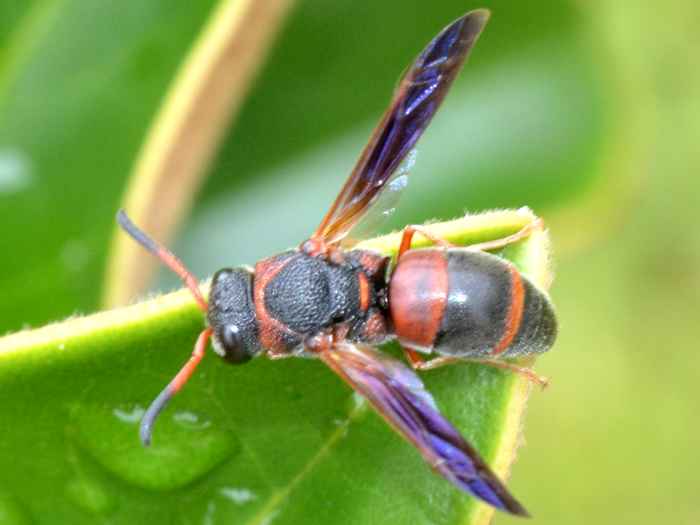 Pachodynerus erynnis (Red-Marked Pachodynerus). | I believe this specimen belongs to the Potter and Mason Wasps. Probably the Red-Banded Mason Wasp Pachodynerus erynnis. This wasp is common in the Southeastern US and often builds nests under the siding boards of buildings. bug guide (this photo): http://bugguide.net/node/view/572049 Texas A&M: http://alturl.com/5kdfk | ||
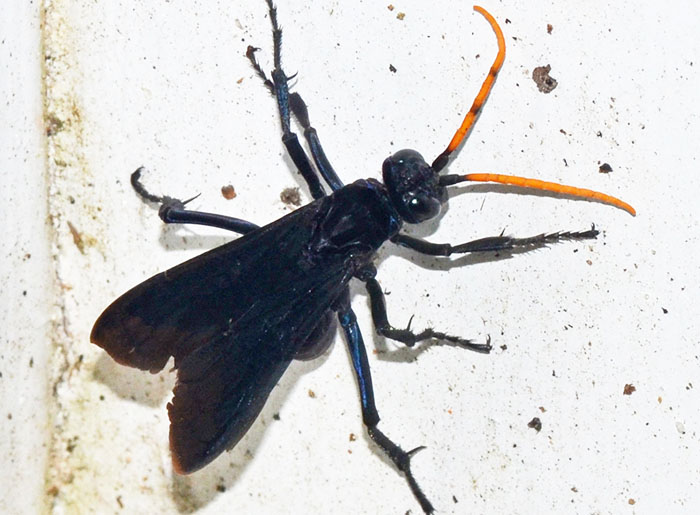 Pepsis menechma (Elegant Tarantula Hawk) ♀. | Elegant Tarantula Hawks are widespread in the eastern half of the US and hence typically do not prey on tarantulas but females rather paralyze trapdoor spiders for provisioning their nests. Adults take nectar. The large wasp is black with metallic bluish tint and orange antennae. Although rather docile, tarantula hawks in general have among the most painful stings on the planet.
bug guide (these photos): https://bugguide.net/node/view/1579894 National History Museum, Hertfordshire, UK: https://tinyurl.com/EmilyOsterloff2017 | ||
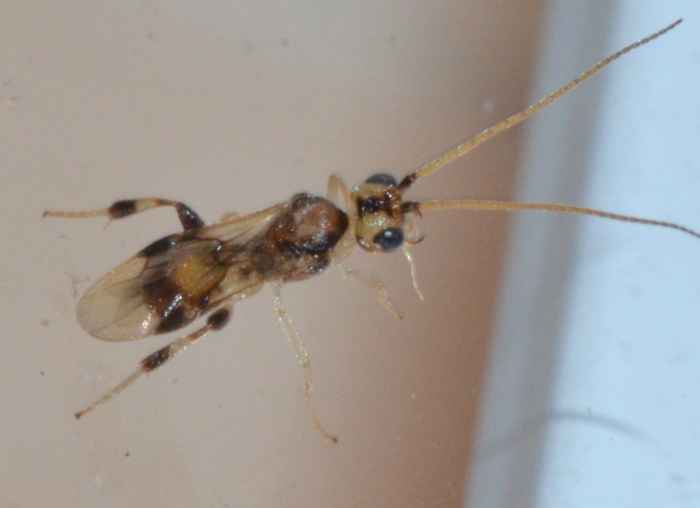 Phanerotoma sp.. | The genus Phanerotoma has 14 species in North America. The wasps in this subfamily parasitize caterpillars of Lepidoptera, especially Pyraloidea and Tortricoidea. Their antennae have 23 segments. The three photos show the same specimen.
bug guide (this photo): http://bugguide.net/node/view/596408 | ||
 Polistes metricus (Paper Wasp). | That's a pretty big 'paper wasp' cleaning its antennae on a jasmine leave. There are sooo many wasps and bees but it really looks like Polistes metricus. Males and females have yellow and red/brown faces, respectively. So this one is likely a gal. Only the females sting.
They mainly feed on caterpillars, which surprises me because I haven't found any recently. They have an interesting life cycle as described on the wikipedia page. bug guide: http://bugguide.net/node/view/60264 wikipedia: http://en.wikipedia.org/wiki/Polistes Texas A&M: http://insects.tamu.edu/fieldguide/cimg348.html | ||
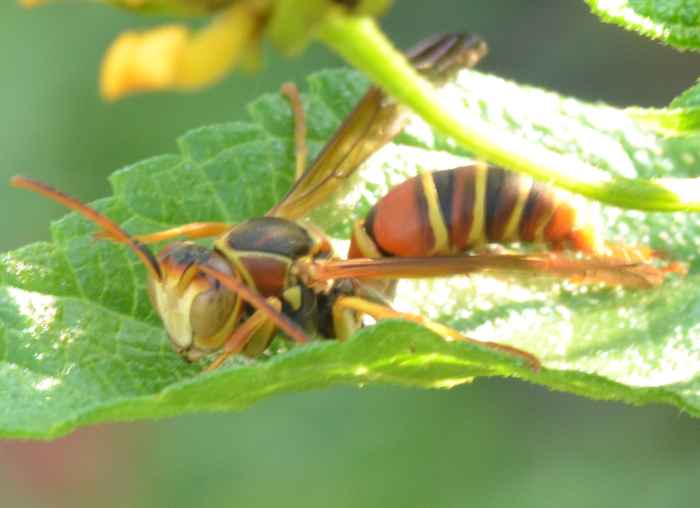 Polistes dorsalis (Paper Wasp (nonspecific)). | This colorful paper wasp is Polistes dorsalis resting(?) on a lantana leave. The genus has 18 or 19 species in the US and Canada. So I have still a few to go.
bug guide (these photos): http://bugguide.net/node/view/569239 | ||
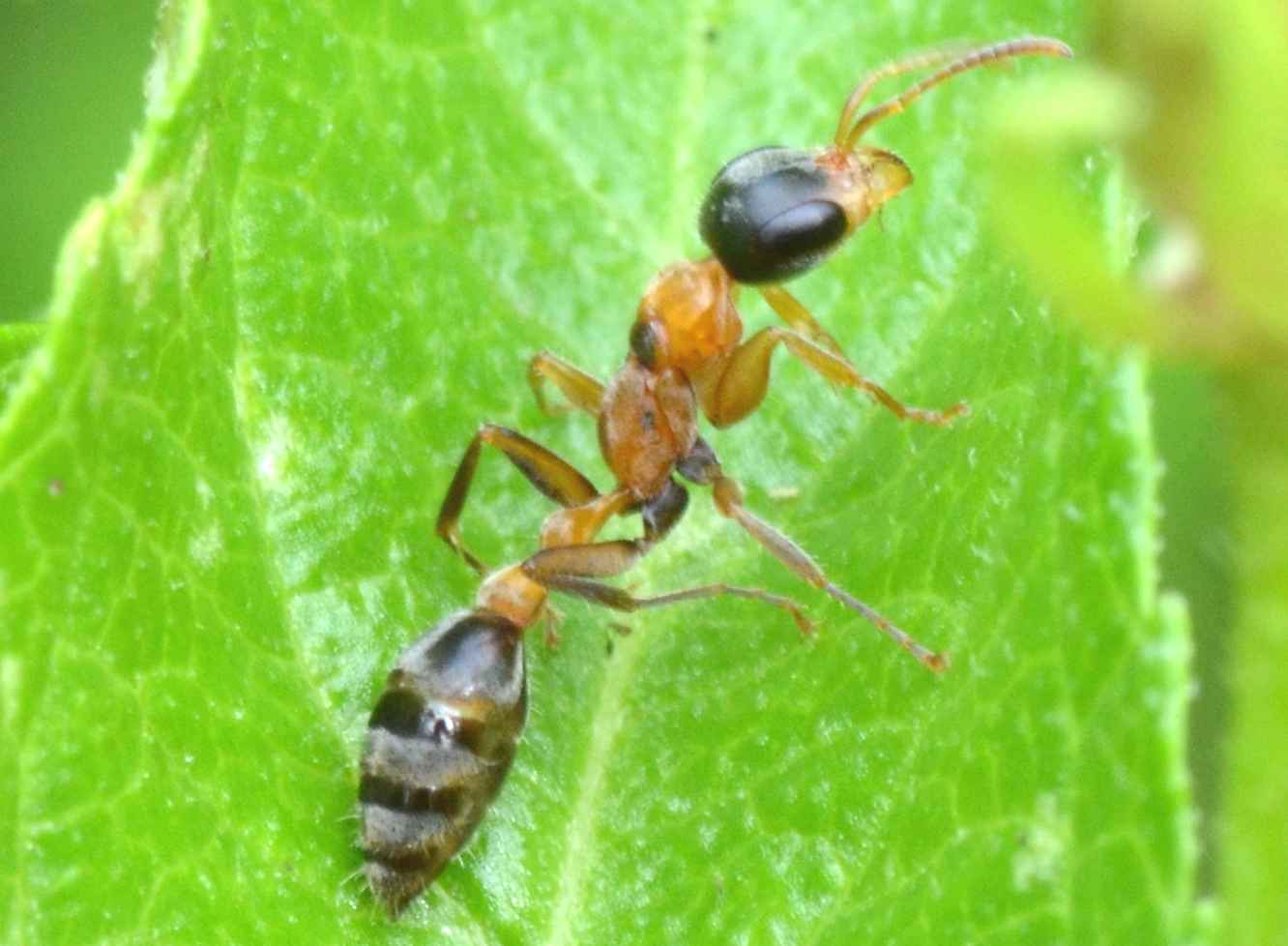 Pseudomyrmex sp. (gracilis ?) (Elongate Twig Ant). | Since the 1960s the Elongate (or Mexican) Twig Ant (Pseudomyrmex gracilis) has become widespread in Florida. It has a painful sting. Nests are small (few ants), have a single queen, and one small entrance. Unlike other species in this genus, P. gracilis is not an acacia-specialist, but nests in a wide range of vegetation. This specimen was darting swiftly over my lantana leaves, which made it difficult to take this photo. There are other Pseudomyrmex species in Florida. bug guide (this photo): http://bugguide.net/node/view/563767 J. K. Wetterer, Fl. Entomol. 93, 535, 2010: http://www.fcla.edu/FlaEnt/fe93p535.pdf UF: http://edis.ifas.ufl.edu/pdffiles/IN/IN75200.pdf | ||
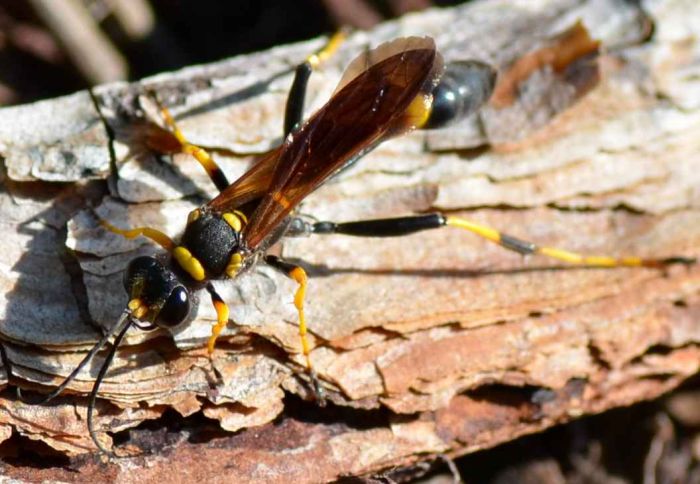 Sceliphron caementarium (Black and Yellow Mud Dauber). | This looks like a 'black and yellow mud dauber' (Sceliphron caementarium). These solitary (thread-waisted) wasps build their nests on houses etc. The mud nests consist of several vertical tubes. The species name is the Latin word for mason. The wasps are about one inch long, do not defend their nests aggressively, and stings are reportedly rare. The small image was taken on 05/27/17.
bug guide: http://bugguide.net/node/view/6610 wikipedia: http://en.wikipedia.org/wiki/Black_and_yellow_mud_dauber | ||
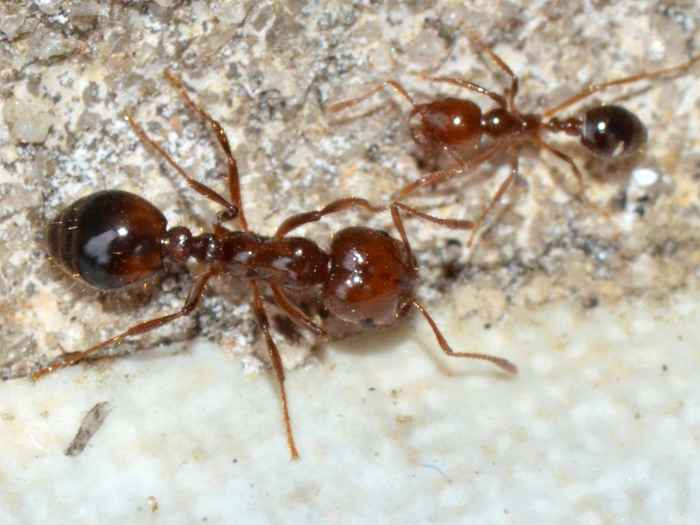 Solenopsis invicta (Red Imported Fire Ant). | The infamous Red Fire Ant (Solenopsis invicta). It was introduced into the US from South America around 1940. The workers protect their nest by stinging the feet and legs of the intruder. The stings cause small but very painful wounds that develop into itchy pustules. The postules can become infected. Interestingly Martineziana dutertrei is a small scarab beetle that lives in fire ant mounds. The photo below shows a winged specimen and was taken on 06/16/12 (7 pm).
bug guide (this photo): http://bugguide.net/node/view/588395 | ||
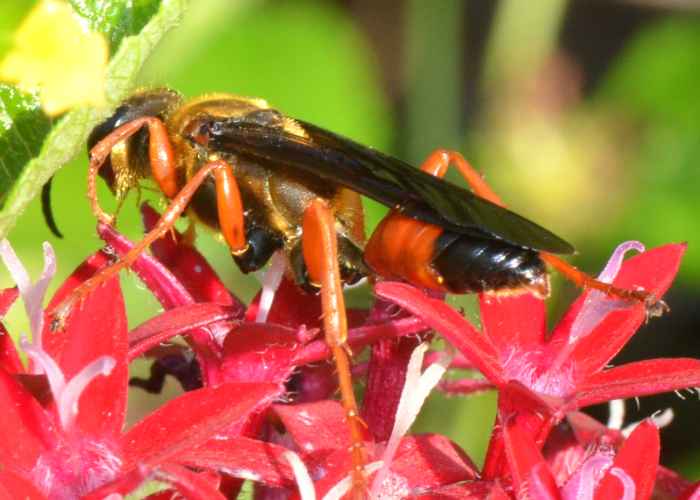 Sphex ichneumoneus (Great Golden Digger Wasp). | The Great Golden Digger Wasp (Sphex ichneumoneus) is found throughout the US. Females dig burrows almost vertically into sandy soil. Radiating out from the central tunnel are cells. Each cell holds one larva and one paralyzed cricket etc. as provision.
bug guide (these photos): http://bugguide.net/node/view/571581 | ||
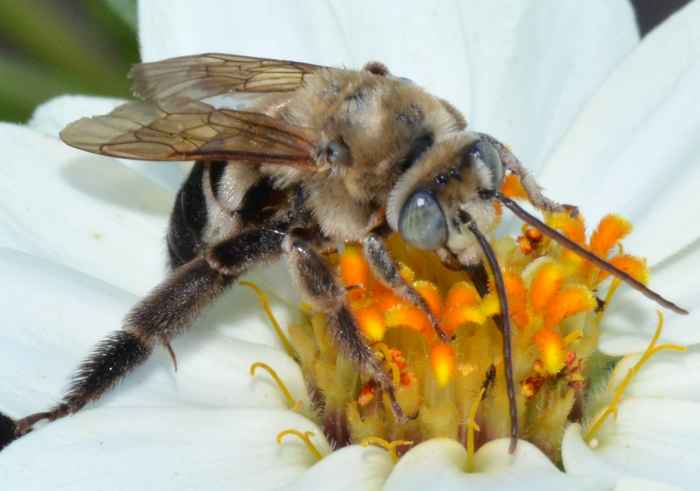 Svastra sp. (Long-Horned Bee (nonspec.)). | We have many of these Long-Horned Bees (Svastra sp.) flying around our petunias and lantanas. Although they have been there for weeks, it took me a long time to shoot a good photo. They are pretty fast and only stop for seconds while taking nectar. This genus has 14 species in our area, which are all robust and hairy.
bug guide (these photos): http://bugguide.net/node/view/569659 | ||
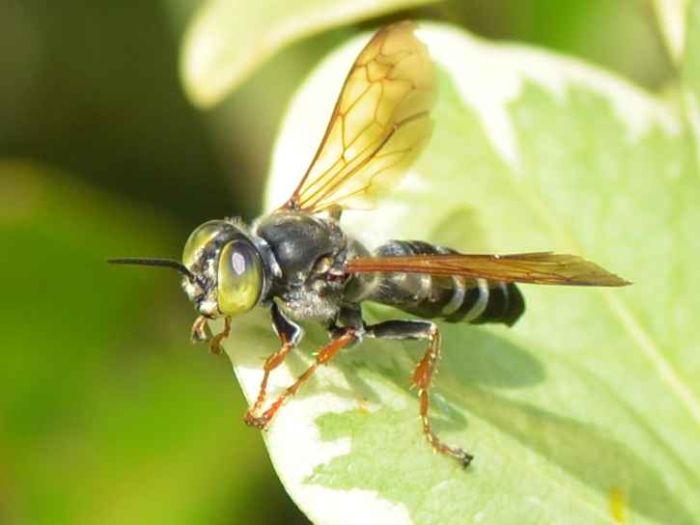 Tachytes sp. (Green-Eyed Wasp). | This green-eyed wasp belongs to the genus Tachytes which has 35 species in North America. bug guide (this photo): http://bugguide.net/node/view/556764 | ||
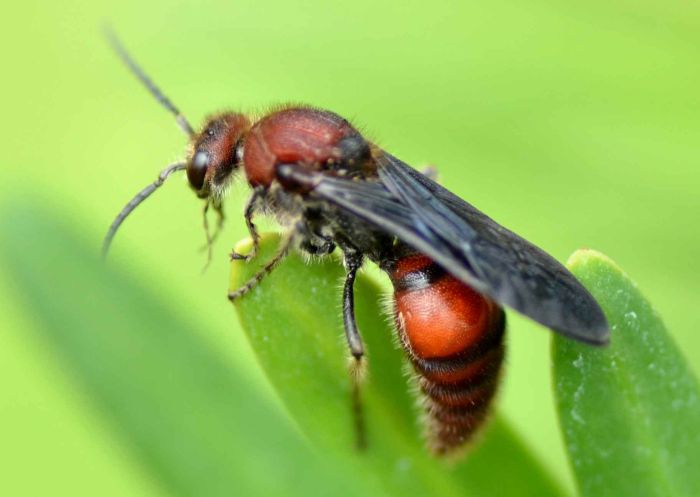 Timulla sp. (Velvet Ant) ♂. | I would have never guessed it but this is a velvet ant (Mutillidae) which is a large family of wasps. Females have no wings and are more hairy than their larger male counterparts. This one belongs to the genus Timulla. bug guide (this photo): http://bugguide.net/node/view/547315 | ||
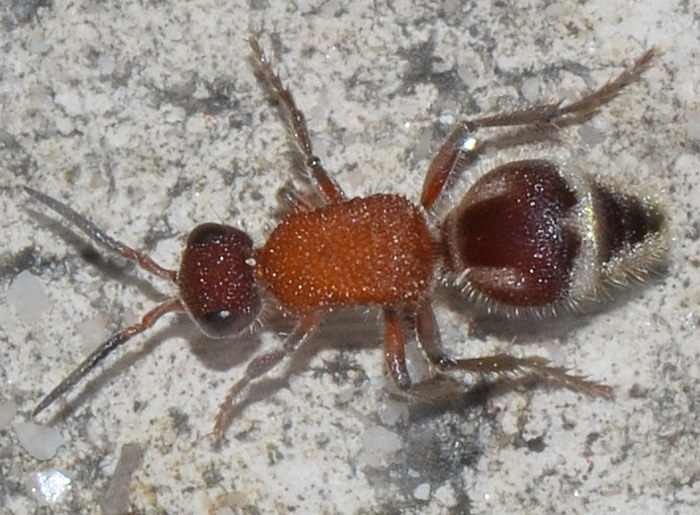 Timulla floridensis ♀. | A Floridian velvet ant. The male in the entry above could possibly be in the same species. bug guide (this photo): http://bugguide.net/node/view/1223611 | ||
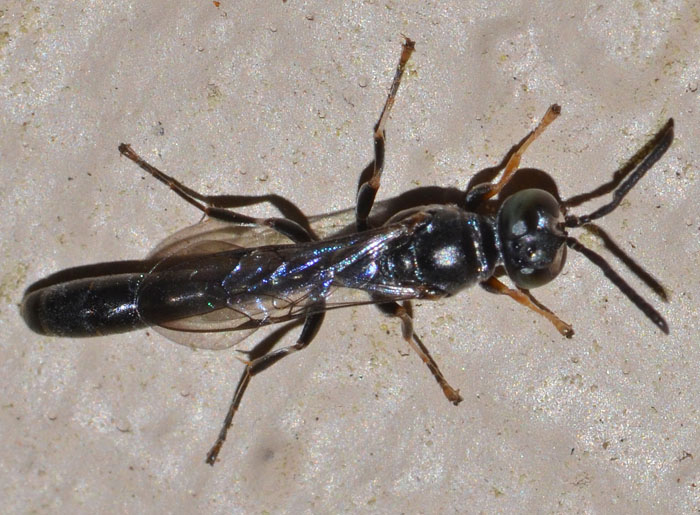 Trypoxylon sp.. | A square-headed wasp in the genus Trypoxylon which has 29 species in the US. Distinctive features are the "notched" eyes and the club-shaped abdomen.
bug guide (this photo): http://bugguide.net/node/view/1054332 | ||
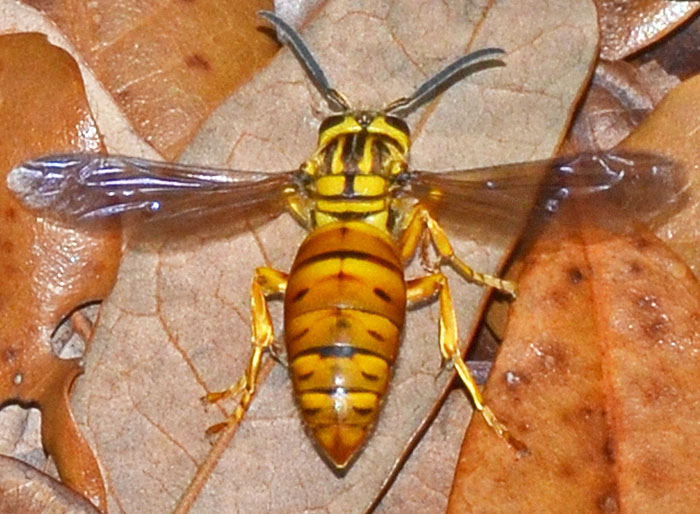 Vespula squamosa (Southern Yellowjacket). | The southern yellowjacket can be identified by its distinctive black and yellow patterns. This one is likely a queen (see UF link, Fig. 2). They create enormous, multiple-comb nests. One of the largest reported nests was 114 cm (45") in diameter. Their stings are venomous causing pain and workers can sting several times. On the upside, they also destroy many insects that otherwise attack cultivated and ornamental plants. bug guide (this photo): http://bugguide.net/node/view/1368650 wikipedia: https://en.wikipedia.org/wiki/Vespula_squamosa UF: http://edis.ifas.ufl.edu/in238 | ||
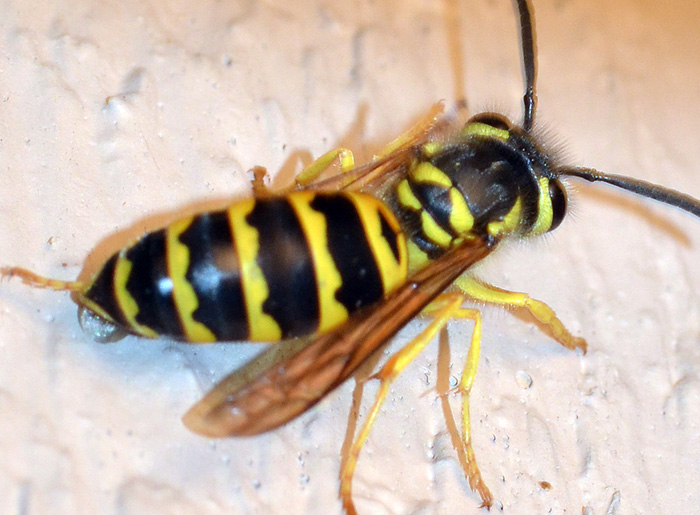 Vespula maculifrons (Eastern Yellowjacket). | Eastern yellowjackets aggressively defend their hives from threats and are known to inflict painful stings. Their colonies are normally subterranean, but sometimes at ground level in fallen logs or on buildings. In late summer, workers construct special larger cells to rear new queens. Males develop from unfertilized eggs and mate with the new queens, which then leave the natal colony to hibernate. The old colony declines and all remaining individuals perish.
bug guide (these photos): https://bugguide.net/node/view/1734206 | ||
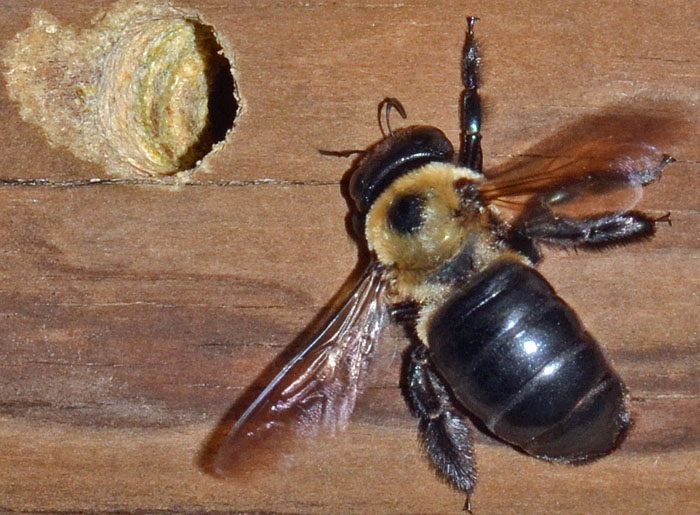 Xylocopa virginica (Eastern Carpenter Bee) ♀. | Female underneath my balcony. From Balduf (see link): "In new nests, female bees chewed their way into the wood, excavating a burrow about 15 mm in diameter. If the grain were oriented vertically, the nests were vertical; if horizontally, then the nests were horizontal with respect to the ground. Galleries extended about 30 to 45 cm in newly completed nests. These older galleries were believed to have been used by several generations of bees. After excavating the gallery, female bees gathered pollen, which was mixed with regurgitated nectar. The pollen mass was placed at the end of a gallery, an egg was laid, and the female placed a partition or cap over the cell composed of chewed wood pulp. This process was repeated until a linear complement of six to eight end-to-end cells was completed." UF: http://edis.ifas.ufl.edu/in257 | ||
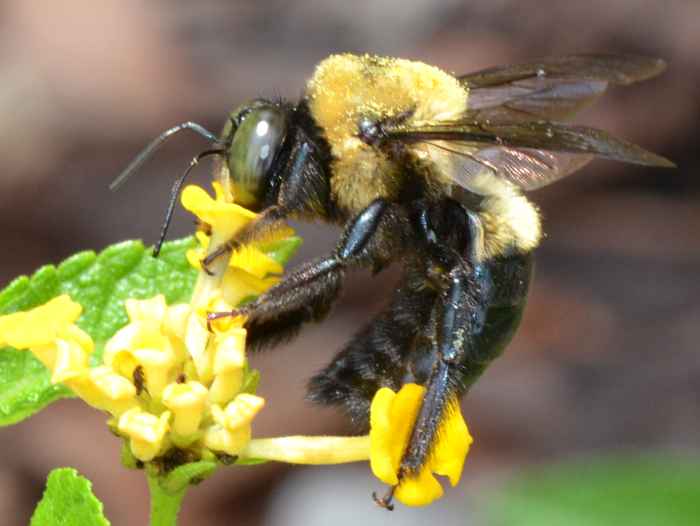 Xylocopa virginica virginica (Eastern Carpenter Bee) ♂. | A rather big bee with yellow "fur" on the thorax and a black hairless abdomen. This is a Common Carpenter Bee (Xylocopa virginica). They build their nests (galleries) in dry wood, especially in conifers. Carpenter bees only rarely damage varnished or painted wood.
bug guide (these photos): http://bugguide.net/node/view/572578 UF: http://edis.ifas.ufl.edu/in257 |

